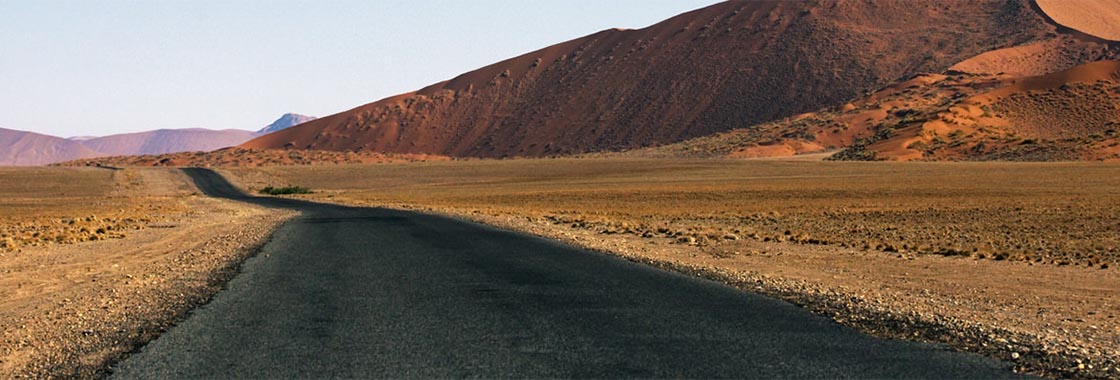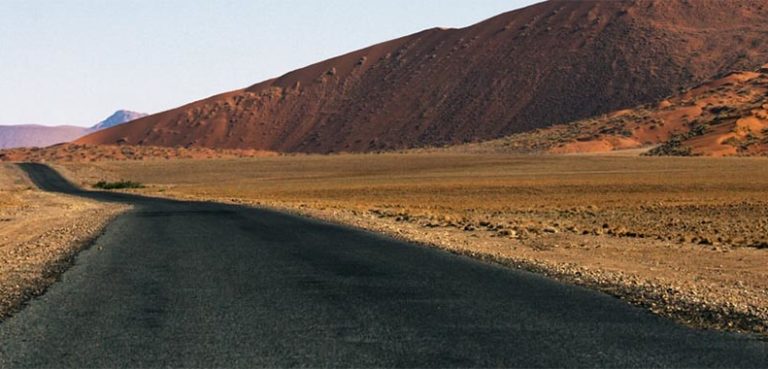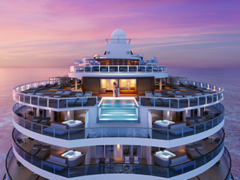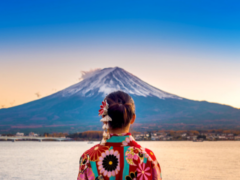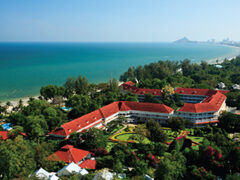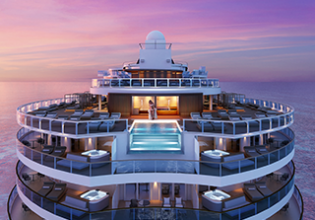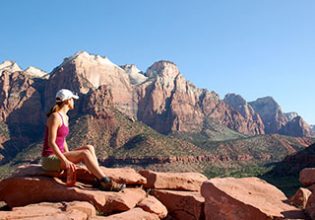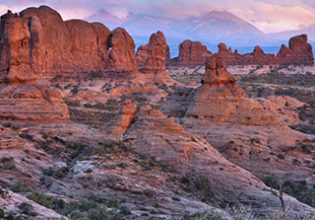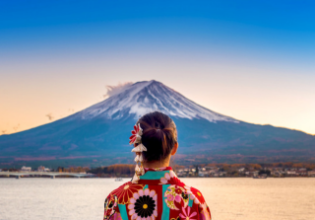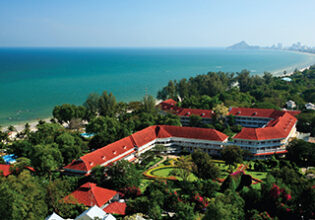It’s a journey consuming the imagination of every soon-to-be school leaver and soon-to-be-retired professional alike: a one-off, round-the-world odyssey of epic proportions, free from the constraints of the everyday. And if you don’t have the time (or the capital), well then you can just pick some highlights from this: a tailored itinerary of 100 jaw-dropping spots on our radar this year.
First leg: Australia to South East Asia
1. See Australia’s wild side (Carbon-Free)
Australia is a big, wide, brown land ripe for exploration, necessitating a set of dune-busting wheels to give you the freedom to explore it. We’re rightly obsessed with our 4WDs, but with the advent of powerful electric motors and batteries that enable 600-kilometre-plus ranges, it won’t be long before we needn’t leave a trail of exhaust behind us.
Startup company Jaunt has spotted an opportunity and is retrofitting gorgeous classic Land Rovers with advanced electric drivetrains for people to go on road trips through Byron Bay and the Blue Mountains in New South Wales, and Daylesford in Victoria, with more destinations to follow.
“One of the simplest reasons I want Jaunt to exist, is so I can drive through the bush and hear it. The bush that is. While the sound of tyres on the track crunching twigs and gum leaves blends in like footsteps do, the sound of an engine doesn’t,” co-founder Dave Budge tells International Traveller.
“At a larger scale, I’ve become increasingly aware of how much fuel I’m using to get to pristine natural places.
“Australia has a love of 4WDs and SUVs, plus a dry climate that means thousands of old vehicles are still in great condition. We think upcycling classic vehicles that fit into our imagination of adventure, means we can create something both nostalgic and progressive.”
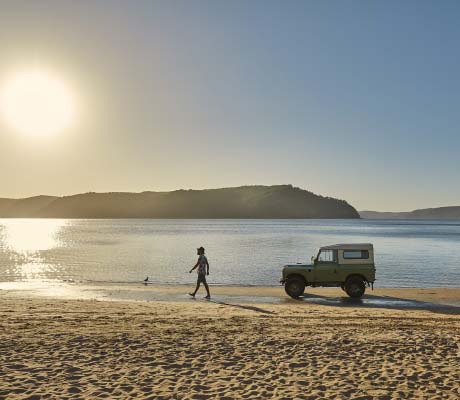
See Australia’s wild side with Jaunt
2. The luxe Fullerton Sydney has arrived
The Fullerton hotel group seems to have a thing about GPOs. Its original property, the magnificently grand Fullerton Hotel Singapore, opened to much fanfare in 2001 in the former government post office, and now the latest property to join its portfolio, The Fullerton Hotel Sydney, encompasses the grand facade of the historic GPO on Martin Place.
The former Westin Sydney will be officially reborn as a Fullerton Hotel in October, presenting the city with an elegant five-star property that will provide the levels of service that its sister hotels (including The Fullerton Bay Hotel Singapore) have long been renowned for.
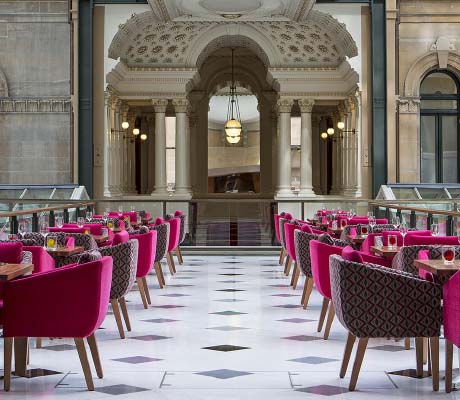
The Fullerton hotel delivers luxury to Sydney
3. Cross the Australian expanse by train
Crossing the Australian expanse on the Indian Pacific takes you through the exquisite isolation of the Nullarbor and into the nostalgic, digital-free world of train travel.
Aboard you can follow the path of bush pioneers, gold rush prospectors and legendary adventurers as you make an epic transcontinental crossing. The brochure touts fabulous feasts and wicked wine but, curiously, makes no mention of the onboard entertainment: tantalising tales of clandestine love trysts and rumours of civil war that lure you in during the 4352-kilometre journey.
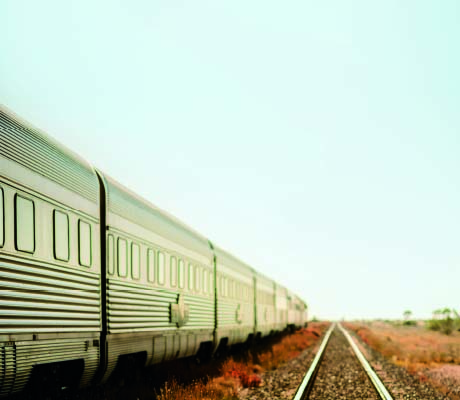
Experience the nostalgic, digital-free world of train travel
4. The Jungle Paradise of Christmas Island
Geographically closer to Asia than to mainland Australia, the atypical tropical paradise that is Christmas Island – over 2600 kilometres north-west of Perth – is one of our country’s best-kept travel secrets: a beguiling mix of dense jungle, dramatic coastline, hidden swimming spots, world-class diving, astonishing wildlife (including its famous red crabs that you’ll encounter everywhere on the island, and not just during their annual migration) and a culturally diverse community. Stay in the thick of it at Swell Lodge, an eco-retreat perched on the edge of the Indian Ocean, to feel at home in this place that feels like nowhere else on the planet.
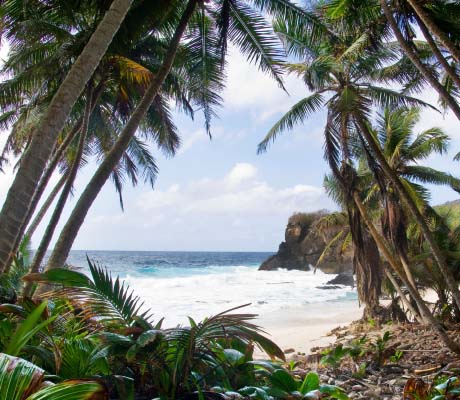
The atypical tropical paradise that is Christmas Island
5. Check into one of Bali’s luxe new openings
There’s never a time when Bali isn’t a great option, but an endless stream of new accommodation offerings is enhancing its allures (the beaches of Canggu, the verdant rice fields of Ubud, the stunning traditions, the gracious people, the nasi goreng; need we go on?).
Following on from the 2018 openings of the game-changing Capella Ubud, a luxe tented camp woven through the lush landscape (no trees were removed during construction; indeed, the design was adapted to accommodate them), wellness retreat Six Senses Uluwatu and the ultra-sophisticated Apurva Kempinski Bali Resort in Nusa Dua in early 2019, there is a veritable who’s who of hotels on the horizon: Jumeirah Bali in exclusive Jimbaran, an outpost of the funky Kimpton brand, an Andaz, two Waldorf Astoria properties (one set to open in 2020 and the other in 2021), a second W property on the island, this time in Ubud, and the boutique Nirjhara, located near the sacred Tanah Lot temple.
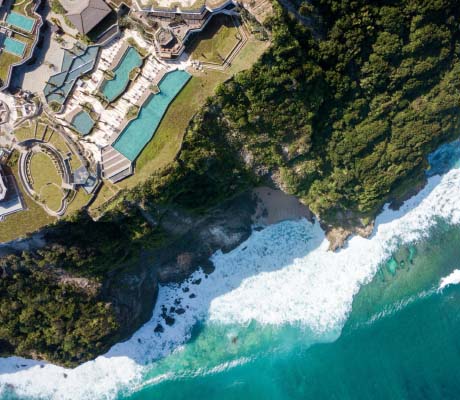
Check into one of Bali’s luxe new hotels
6. LOMBOK: Indonesia’s other island paradise
Located just 25 minutes’ flying time east of Bali (or four hours by high-speed boat), yet a world away from its busy throng, Lombok is a laid-back paradise of beaches, waterfalls and rice fields dotted with a modest number of resort hotels (by its neighbour’s standards).
While some say that Lombok is what Bali was 30 years ago, the island has its own unique personality, informed by the beliefs (its population is predominantly Muslim) and traditions of its inhabitants. Having been devastated by a trio of earthquakes in 2018, the island is keen for visitors to return to wonder at sights like the Segara Anak crater lake on the volcanic behemoth of Gunung Rinjani, stroll the Dutch colonial buildings in Ampenan, walk to the waterfalls of Singang Gile and Tiu Kelep or just bliss out on an uncrowded beach.
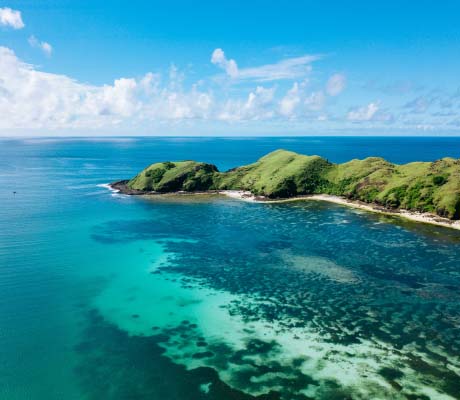
Bliss out in Lombok
7. Asia’s best schmoozy beach clubs
Historically the beach club was a European affectation, where coveted stretches of sand were cordoned off for use by the privileged few, but it is in Asia where the modern incarnation is reaching new and heady heights.
Bali has a lock on some of the most stylish and popular of these: places like the imposing Potato Head in Seminyak, with its soaring facade of old shutters, the stylish OMNIA Dayclub perched on a clifftop at Uluwatu, and the members-only Karma Private Beach Club, where you can go to eat, drink and dance to DJ sets. Never one to be left behind, Singapore has its own suitably chic offering – Tanjong Beach Club on Sentosa Island – while the Thai island of Phuket boasts an outpost of Ibiza’s Café del Mar. We’ll drink (and dance) to that.
8. RAFFLES: a classic reborn
One could argue that Raffles in Singapore is the most famous hotel in the world. Its name instantly conjures up visions of gracious hospitality steeped in history and tradition, so the announcement that it was to undergo a multi-million-dollar renovation had purists worried. Would its old-world charms be sacrificed for sleek homogeny? Anyone glimpsing the results would have to answer a resounding ‘no’.
The neoclassical landmark positively sparkles from its makeover, which has modernised the bits that needed it (the bathrooms and technology – iPads now control lights and summon your personal butler) and enhanced the bits that didn’t, making the lobby more welcoming, reinstalling the Writers’ Bar and adding an airy new restaurant, La Dame de Pic by Michelin-starred chef Anne-Sophie Pic.
9. Bangkok on the rise
Of all the Asian cities experiencing an onslaught of hotel arrivals on the landscape, nowhere is it more pronounced than the Thai capital of Bangkok. The city skyline is increasingly being dominated by futuristic architecture that would give New York and Tokyo a run for their money.
In the next few years, the city will be the recipient of a Capella resort, a Langham hotel and a Kimpton property. But the opening worth pencilling into your diary for later this year is the Orient-Express Bangkok, which will not only mark the revival of the venerable brand, but also herald the triumphant return to the Bangkok dining scene of award-winning Australian chef David Thompson.
10. The underwater wonderland of the Philippines
We always like to think that our own Great Barrier Reef is the global epicentre of diving and snorkelling with its dazzling variety of coral, but on paper the highest concentration of coral species can actually be found in the waters of the ‘coral triangle’ centred on the Sulu-Sulawesi Seascape, 70 per cent of which resides in the Philippines.
This means you have to swing by the islands on any self-respecting round-the-world journey to see its underwater wonders, whether to dive or snorkel. Book a live-aboard charter with the likes of liveboard, which will ferry you out to the spectacular Tubbataha Reefs Natural Park (TRNP), a UNESCO World Heritage Site in the Sulu Sea, to swim with white tips, grey reef sharks, manta rays, eagle rays and turtles, and if you’re lucky, whale sharks.
Deals
Second leg: South East Asia to Asia
11. Vietnam’s bizarre desert of Bao Trang
Who’d have thunk it? An arid desert landscape in Vietnam – and it’s just a short drive from Mui Ne, an atmospheric coastal resort town with fishing vessels and traditional bamboo boats lining its shores. In contrast, the desert landscape north of here is a vast expanse of rolling white sand dunes complete with its own oasis: freshwater Lotus Lake, dotted with pink lotus flowers.
It is a popular spot for adventure pursuits such as quad-biking, dune-bashing in a Jeep, sandboarding and hot-air ballooning over the ethereal landscape. There are also smaller dunes that are a dramatic fiery red (‘doi hong’) closer to town, and that’s where you’ll find Fairy Spring, a stream that cuts through the red landscape.
12. Cambodia’s ultimate wild retreat
Designer Bill Bensley is a born storyteller – I have seen him hold a room full of travel industry insiders enthralled as he described the hotels and resorts he has designed from Luang Prabang to Bali. Indeed, he has said that storytelling in hospitality is his big thing.
This seems obvious when you see the pristine beauty that forms the backdrop for his passion project, Shinta Mani Wild. The camp occupies 350 hectares of land on the southern border of Cambodia’s Cardamom National Forest, bought by Bensley and Cambodian businessman Sokoun Chanpreda (founder of the Shinta Mani Foundation), back in 2010 in order to protect it from the scourge of poaching, mining and logging.
Meticulously planned out (Bensley and architect Prajak Thaijanthararak visited the concession of land over 50 times in seven years), the resulting luxury encampment treads oh-so-lightly on the landscape that it nestles in. The 15 accommodation tents were built around the existing trees; there is a ranger’s station on site, reflecting a partnership with the Wildlife Alliance; a resident naturalist assists the chef with sourcing ingredients; and Chanpreda’s Shinta Mani Foundation oversees the resort’s conservation and community outreach programs. It goes without saying that there are no single-use plastics used and recycling is king.
Beyond its impeccable environmental and social credentials, the other big story at Shinta Mani Wild is the irreverent design, a hallmark of Bensley’s style. Each tent is individually named and decorated around a corresponding theme: the First Lady Jackie Kennedy’s Tent commemorates the former US First Lady’s 1967 visit to Cambodia. You can take home the Bensley-designed, custom-made furniture in exchange for a donation to The Wildlife Alliance if you like.
And for the ultimate dash of Bensley wit and whimsy, guests can opt to arrive at the camp via a 380-metre-long zip line over the river it sits on, ensuring that they’ll have their own Shinta Mani Wild story to tell too.
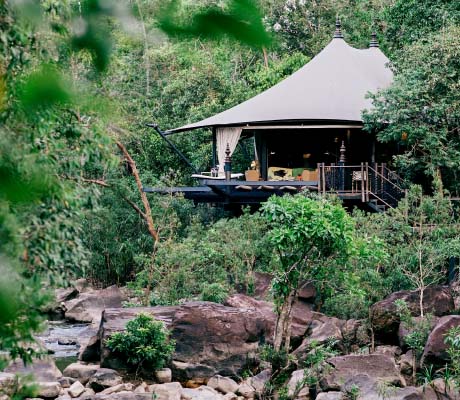
The camp occupies 350 hectares of land on the southern border of Cambodia’s Cardamom National Forest
13. Malaysia on the radar
After a period of political uncertainty, Malaysia is once again challenging its neighbours for the attention of travellers. A lot of this has to do with the arrival of a clutch of new hotels and resorts that are firmly at the luxury end of the scale. Long the benchmark for Asian resort style, The Datai on the island of Langkawi emerged from a multi-million-dollar renovation late last year looking fresh and sleek and with a new focus on the environment.
One&Only is about to debut its luxury beachfront resort and private residences at Desaru, while the island of Penang, with its buzzing food scene, has new luxury hotel The Prestige, which rifts off the rich history of its UNESCO World Heritage-listed capital, Georgetown, while at the same time feeling impossibly fresh and modern.

Malaysia’s hotel properties are putting it back on the map
14. Elephant-adjacent jungle bubbles in Thailand
With its celebrated focus on elephant conservation and its continued work with the Golden Triangle Asian Elephant Foundation, Anantara Golden Triangle Elephant Camp & Resort, located in Chiang Rai, has long put the welfare of the 20 or so elephants who live in its Elephant Camp front and centre. Rescued from illegal logging camps, elephant shows and the streets, the elephants can often be found roaming the resort’s 64 hectares of bamboo forest and fields, and with the opening of two specially designed jungle bubbles later this year, guests can get just that little bit closer to these gentle giants. The clear igloos will be positioned on a platform in the middle of the elephants’ roaming area, allowing guests to spend the night under the stars before hopefully waking up to find them tantalisingly close.
15. Hong Kong’s sophisticated and insatiable food scene
When we think about eating in Hong Kong, minds and stomach inevitably wander to street food vendors and their array of exciting and often intimidating golden, fried, slippery, sticky things on sticks, or deep bowls of noodles, and all manner of dumplings. But Hong Kong is a truly international city, and with that comes a diverse and world-class food culture that reaches far beyond local flavours. From fine dining to cool bars and authentic Italian, this is a city with an insatiable appetite and a richly textured food scene that grows weekly.
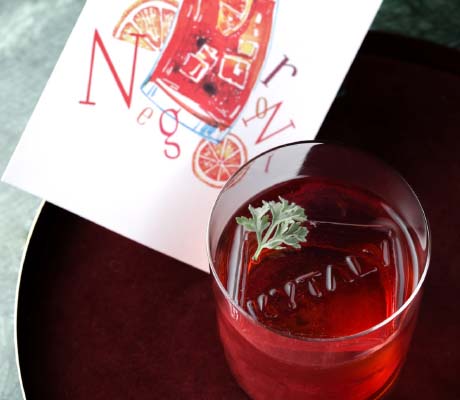
Hong Kong’s sophisticated and insatiable food scene
16. The Hawai‘i of China
It may sound like marketing speak, but Hainan Island has garnered the nickname the Hawai‘i of China for good reason. Sitting at a similar latitude to the US state, Hainan Island boasts a tropical climate, golden-sand beaches, a thriving surf scene, and more than 150 resorts on its idyllic shores, including global brands such as Capella Sanya (opened late 2018) and a Kimpton resort (opening 2020) in the main resort hub of Sanya.
While it has all the characteristics of a relaxing beach break, the island destination also offers a cultural fix with a tasty local cuisine (including famous Hainan chicken), historic towns and architecture (some streets date back 400 years), traditional arts (such as textile weaving by the island’s Li ethnic group), as well as hiking, zip lining, golfing and the like. Rainforest makes up two-thirds of the island, providing a change of scenery, albeit an equally captivating one, with waterfalls, streams and valleys.
17. Shenzen: the future is now
What will the world be like in, say, 20 years? You need look no further than just north of Hong Kong to the south-east tip of China and the city of Shenzen. The metropolis of some 12 million people is a cutting-edge hub of innovation, a hyper-speed version of Silicon Valley, its streets whirring with electric vehicles below clusters of striking skyscrapers that become ablaze with neon signage come night.
Its growing population of some of the country’s sharpest young minds who come to work for the many international tech brands based here means it’s also at the forefront of a new creative wave, the city now positioning itself as the arts capital of China. Head to the OCT Contemporary Art Terminal to see exhibitions of some of China’s most exciting new conceptual artists, channelling the electric energy of this UNESCO City of Design.
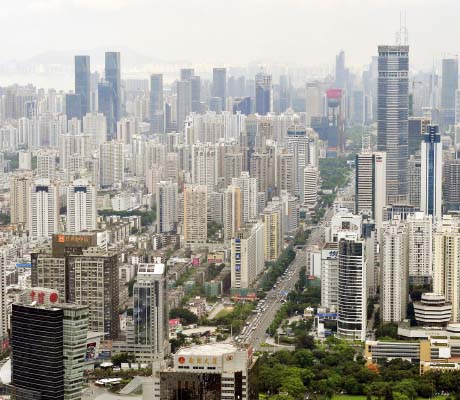
Shenzen: a cutting-edge hub of innovation
18. Tokyo in living colour
With a possible nine million tickets to the Tokyo Olympic Games up for grabs and nearly one million overseas visitors set to descend from 24 July to 9 August, things are set to get pretty crowded in the Japanese capital in summer 2020. But the fact is Tokyo presents a stunning proposition all year round: visit during the months of March and April to witness the ephemeral beauty of the cherry blossom; see the landscape explode in a riot of russet and red as the leaves turn in autumn, and visit in winter to see Mt Fuji drenched in pearly white snow.
19. The Okura Tokyo – then and now
Devotees of modernist design were devastated when it was announced the Hotel Okura Tokyo, a masterpiece of mid-20th-century architecture was to be demolished to make way for a new hotel – The Okura Tokyo. The location for Vogue fashion shoots and James Bond novels (You Only Live Twice), the hotel was completed in 1962 and boasted an ultra-modern aesthetic that melded with traditional Japanese motifs and styles – the lobby space was its crowning glory. The redesign was helmed by architect Yoshio Taniguchi whose father, Yoshiro Taniguchi, led the original design team, and will feature 550 rooms, the latest technology and gadgets, and state-of-the-art earthquake proofing. As for the purists, there’s some solace in the fact that the new lobby will be an updated version of Taniguchi Senior’s iconic original design.
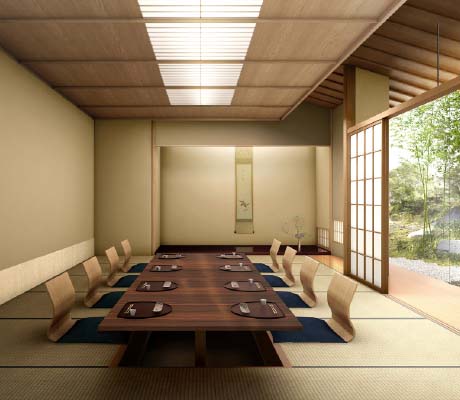
The Okura Tokyo is due for an exciting new upgrade
20. Okinawan luxury
Tropical island paradise is not the first thing that springs to mind when thinking of all things Japanese, but it should. Scattered across the sea that stretches from Japan to the Philippines, the islands of Okinawa are blissfully unconcerned with overtourism. Deep deserted beaches, unique traditions informed by its history as part of the ancient Ryukyu kingdom, delicious cuisine and a sybaritic pace of life present an irresistible proposition. Make time for the islands of Ishagaki and Taketomi, and then spend a few days at the newly minted five-star Halekulani Okinawa.
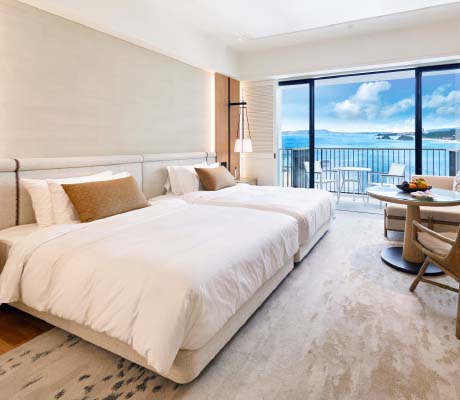
Luxury in Okinawa
Deals
Third leg: Asia to Africa
21. Land of the tigers
In a world of seemingly endless bad environmental news, now and then it’s affirming to hear a little of the good stuff. Once thought to be in terminal decline owing to habitat loss and poaching for products in the Asian traditional medicine market, the tiger, that intoxicatingly romantic mix of equal parts beauty and ferocity, is recovering in its stronghold of India. In a recent national survey, nearly 3000 tigers have been observed in the country, a number up six per cent every year since the last census in 2014.
Humankind fail averted for now, but work is still ongoing to safeguard their future. To celebrate the animal’s tenacity head to the likes of Satpura National Park in the central state of Madhya Pradesh and take a multi-day guided tour to admire the solitary predators in the wild.
22. Soho comes to Mumbai
When Soho House opened in Mumbai at the end of last year, it marked the first foray into Asia for the brand – a private members’ club for creative types that began life in London in 1995 and has since expanded around the world to encompass restaurants, cinemas, workspaces, spas and hotel rooms too. Soho House Mumbai is based in an 11-storey townhouse on the city’s popular Juhu Beach with considered spaces including a library, 34-seat cinema and a rooftop pool.
Indian culture is infused throughout the interior design, including in its 38 bedrooms that feature sisal carpet, antique timber and bone-inlay furniture, plus lampshades made with sari fabrics from local markets. On the ground floor, Cecconi’s Mumbai restaurant and Allis cafe and lounge are open to the public.
23. Bliss out in Sri Lanka
After the devastating Easter terrorist attacks in early 2019, the island of Sri Lanka, sitting in the warm waters of the Indian Ocean, is slowly recovering and returning to some semblance of normalcy. Apparently Australian tourists have been some of the quickest to head back to the destination, re-engaging with its heady allures, from exquisite beaches (try Arugam Bay and Hiriketiya) to a dense, lush landscape that is home to elephants and wonders the likes of the UNESCO World Heritage-listed Lion Rock Fortress at Sigiriya and Yala National Park, with its resident leopards. Another drawcard is the gracious Sri Lankan people, who have overcome adversity in the past and who are sure to triumph over it again this time.
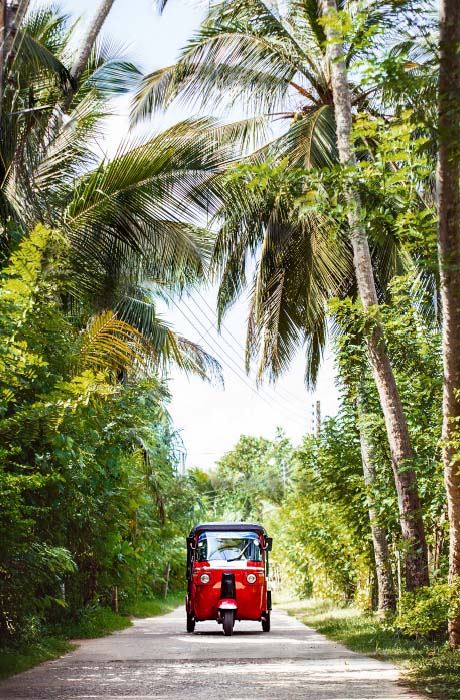
Sri Lankan bliss awaits
24. The Maldives’ new luxe lodgings
The Maldives’ unassailed place at the top of every luxe lover’s wish list shows no signs of abating. It’s understandable considering the superlative-defying beauty of its islands, scattered like confetti across the impossibly blue waters of the Indian Ocean.
Luckily there are plenty of new resorts on the horizon (pun intended) to sate our endless appetite for island idylls: in the next year or so the likes of Pullman, Raffles, Capella, Baglioni, Waldorf Astoria and InterContinental are all set to take up residence, offering up ever more lavish appointments befitting this most luxe of locations.
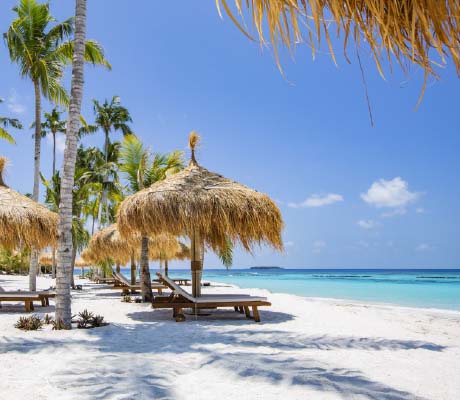
The Maldives showcases the best of impossibly blue ocean
25. Ethiopia goes green
In July of 2019, Ethiopia broke a world record by planting around 350 million trees in one day. It was part of a national ‘green legacy’ initiative to raise public awareness on environmental issues and help restore a landscape that has been challenged by deforestation and climate change. By encouraging every citizen to plant 40 seedlings a day until October, the country – inspired by a recent study indicating that planting 500 billion trees could remove a quarter of the carbon in the atmosphere – hopes to see four billion indigenous trees flourish in that time.
So, with the greening of Ethiopia in mind, it’s time to get with the zeitgeist and explore the country’s vast natural beauty for yourself: situated on the East African highlands, it encompasses high-altitude forests, moors, rivers, waterfalls and lush jungles, and natural treasures like the Simien Mountains National Park – with its herons, storks and hippos and plunging valleys and escarpments.
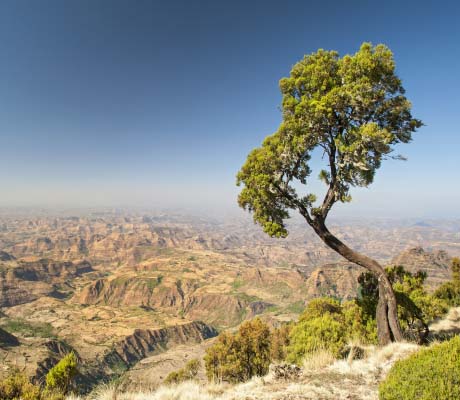
Explore the country’s vast natural beauty for yourself
26. The privilege of Rwanda
The privilege to be in the immediate presence of rare mountain gorillas and the awesome power of a silverback is yours in the jungles of Rwanda, in Volcanoes National Park – and there is now a growing list of fine properties to service this unique wildlife encounter. Luxe new lodges including Singita’s Kwitonda Lodge and Kataza House and the iconic new Biaste Lodge run by Wilderness Safaris are putting Rwanda firmly on the map of well-heeled, design-conscious travellers. It’s also the perfect excuse to get to the country and visit Ellen DeGeneres and Portia de Rossi’s gorilla conservation centre.
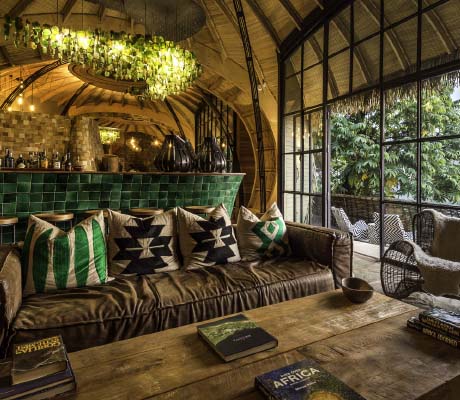
Uncover the beauty of Rwanda
27. Tanzania: Africa encapsulated
Do you find it a tad annoying when people say they are ‘going to Africa’? Where exactly? It’s a big place! Continent-sized, even. We think what they really mean is that they are going to witness lions, elephants and wildebeest patrolling vast national parks, to experience the intriguing ancient cultures of people like the Maasai, and to visit bustling markets selling all manner of colourful crafts. By this definition, if you want to ‘see Africa’, the best place to go is Tanzania.
The country encapsulates the best of the sub-Sahara. You could spend years coming back here to see its World Heritage-listed natural wonders: the planes of the Serengeti or the mind-blowing spectacle of the Ngorongoro Crater; walk up the highest mountain in Africa to touch the snow on Kilimanjaro, or visit the bustling spice bazaars of Stone Town in Zanzibar before snorkelling off the island’s white-sand beaches.
28. Period charm in Cape Town
Every now and then a new property emerges that has you thinking of booking a flight, just to make it your base when travelling abroad. The recently opened Labotessa in the centre of Cape Town sits behind a 17th-century facade on cobbled Church Square, with unobstructed views of Table Mountain and the Lion’s Head.
It’s a distinctly boutique property with just six carefully curated Signature Suites offering a warm, inviting mix of old meets new. Think Persian rugs on French oak floors with antique pieces alongside custom-made designer furniture and contemporary art; the penthouse Governor’s Suite is thought to be the biggest top-floor dwelling in the city.
29. Namibia
When it comes to edge-of-forever vistas, they don’t get much more stunning than in Namibia. Situated on the southwestern coast of Africa, the country of over 2.3 million inhabitants is a vast patchwork of landscapes: the long coastal desert of the Namib; the central plains of unforgiving mountain ranges and sand-filled valleys; the haunting Kalahari Desert; and the surprising green of the Caprivi Strip and Kavango. Indeed, the national tourism board lists ‘the landscape’ as Namibia’s ‘defining national asset’.
The country is also home to a diverse population of indigenous peoples, such as the San, more widely known as the Bushmen, and the striking Himba, who rub their skin and hair with red ochre. And, then there’s the wildlife: lions, cheetahs, elephants, giraffes, rhinos, seals… Game parks and nature reserves take up some 18 per cent of the country.
The best way to see all that Namibia has to offer is by car (or 4WD to be precise); the country is criss-crossed by roads and manageable tracks that snake into almost every nook and cranny of the landscape, allowing those with a sense of adventure (and a valid driver’s licence) to chart their own course across its huge 824,292-square-kilometre expanse. The national tourism board puts it best, enthusiastically encouraging visitors to strike out and experience the country for themselves, ‘and then tell others’.
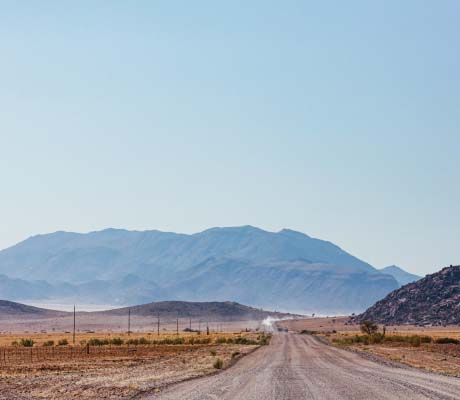
When it comes to edge-of-forever vistas, they don’t get much more stunning than in Namibia
30. The Montauk of Marrakech
The laid-back Moroccan port town of Essaouira is the place those in the know are heading these days. According to Architectural Digest, it is to Marrakech what Montauk is to New York: an easy, breezy two and a half hours west of the bustling city with a refreshing shoreline that fronts the wild Atlantic Ocean.
It’s been a longtime magnet for surfers, kite surfers, artists and musicians including, once upon a time, Bob Marley and Jimi Hendrix. Wander Essaouira’s heritage-listed white-washed walled medina, browse its art galleries and boutiques, and spend a night or two in one of its splendid riads.
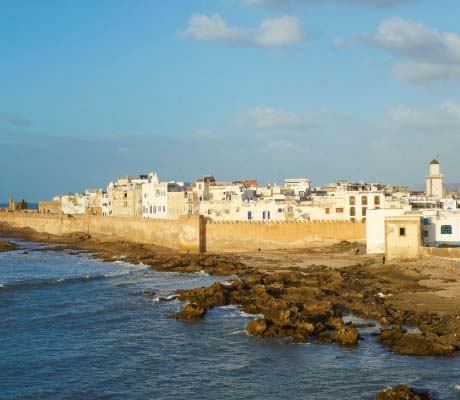
The laid-back Moroccan port town of Essaouira is the place those in the know are heading these days
Deals
Fourth leg: Africa to The Middle East
31. A new temple to Egypt’s past
The 2020 opening of the Grand Egyptian Museum, two kilometres from the Pyramids of Giza, provides another compelling reason to visit Egypt. Set to be the largest archaeological museum in the world, it will house 100,000 artefacts including all 5400 objects from the tomb of King Tutankhamun (including clothing). Visitors will be greeted by none other than the 12-metre-high stone statue of Ramses II – one of ancient Egypt’s most powerful pharaohs – that’s already been placed in situ in the light-filled, pyramid-shaped entrance.
This colossal $1-billion museum will span four millennia of the history of the planet’s first great civilisation as well as, literally, the area of 10 soccer fields. First announced in 1992, it was originally set to open in 2012, but is finally taking shape: the triangular design takes its cues from its famous neighbours and reaches the same height: visitors will be able to gaze out of its glass facades across to the pyramids.
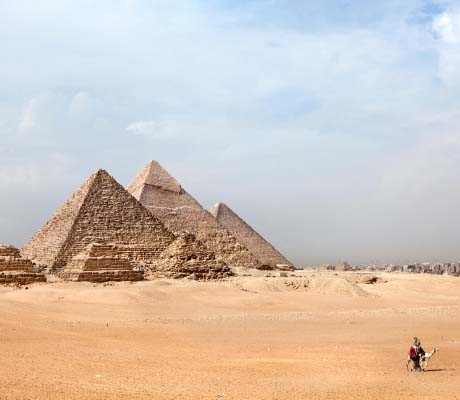
There’s an allure to Egypt
32. Adrift in the Negev Desert
Israel is piquing the interest of an increasing number of travellers these days, who choose to look beyond its tumultuous history and fractuous present to see a land steeped in ancient lore and divine significance. Beyond the religious sites of Jerusalem and the modern buzz of Tel Aviv, the country possesses a rugged beauty that is encapsulated in the almost lunar landscape of the Negev Desert.
Tracking its existence through prehistoric ruins and biblical tales of Abraham, a modern chapter is about to be written with the arrival of Six Senses Shaharut in the Arava Valley. The 60 suites and villas spread across 18 hectares are designed to melt into the landscape rather than dominate it, while Six Senses’ rigourous respect for the environment will ensure its presence does nothing to damage its past or its future.
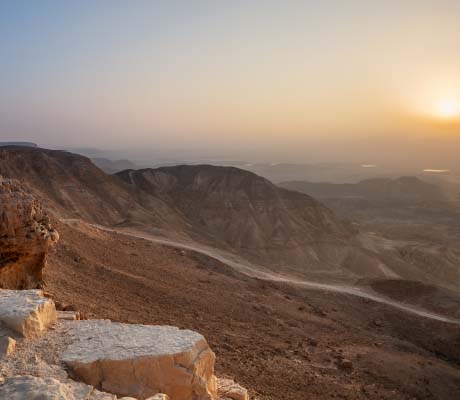
The rugged beauty of Negev Desert
33. (Really) Old meets new in Jaffa
Absorbed into the city limits of Israel’s youthful Tel Aviv in the 1950s, Jaffa is an ancient port town with atmospheric appeal. It’s now also a hotspot for luxury hotels with an indefatigably cool edge that are playing on the area’s rich history; three all-star properties opened in close proximity to each other last year. The 120-room-and-suite Jaffa, a Luxury Collection Hotel was converted from an ornate convent and hospital, with Arabic and neo-Roman flourishes, by architect Ramy Gill and British designer John Pawson; its features have been preserved and modernised, with artwork by Damien Hirst and contemporary Israeli photographer Tal Shochat.
A bar and lounge, called The Chapel, occupies an old prayer space. Nearby, The Setai Tel Aviv is based in a historic Ottoman prison and police station, stylishly updated with a rooftop infinity pool overlooking the Tel Aviv skyline. Just outside Jaffa’s city walls, meanwhile, is The Drisco. Like The Setai, it’s part of the Leading Hotels of the World portfolio, and is the reinvention of Jaffa’s original luxury hotel. Built by American colonists, it operated between 1870 and 1940, and hosted the likes of Thomas Cook and Mark Twain in that time.
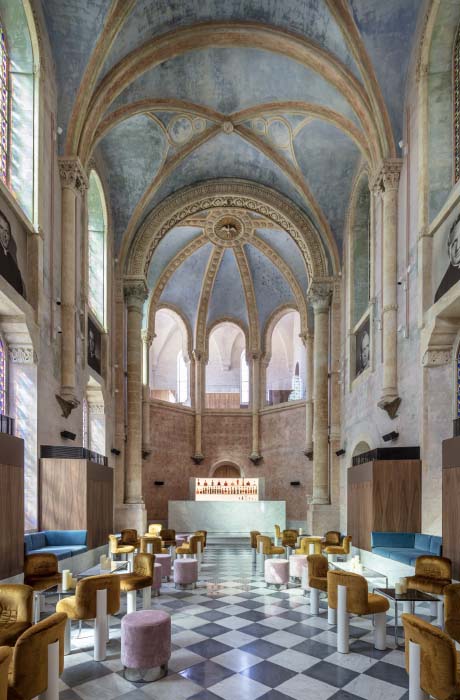
Jaffa is an ancient port town with atmospheric appeal
34. See the Dead Sea before it’s too late
Slathering yourself in mineral-rich mud before wading into the saline Dead Sea to float buoyantly, unnaturally, on its surface is one of the most unique things you can do. Full stop. That it sits at the lowest point on Earth – 430 metres below sea level – only adds to the surrealism.
But the Dead Sea is not actually a sea at all: it’s a landlocked salt lake between Jordan and Israel that is evaporating at an alarming rate: its surface level is dropping about a metre a year, and experts have predicted that it could be reduced to a puddle by 2050 – so get there while you still can. Choose a resort on either the Jordanian or Israeli side to reap the health benefits: not only does the combination of mineral-rich water, soothing mud and sun do wonders for skin conditions like psoriasis, but the oxygen-rich air, with its high barometric pressure, can be beneficial for asthmatics too. But that’s old news: it’s rumoured even Cleopatra used products from the area in her beauty regimen.
35. Dive the Red Sea in Jordan
Jordan’s window onto the Red Sea is just 27 kilometres of coastline, but provides a fantastic diving experience in this otherwise landlocked country, and an alternative diving holiday destination to Egypt’s Sinai Peninsula – which you can see on the horizon.
Its waters are home to an ancient coral reef that seems to have resisted global warming-induced bleaching by having acclimatised to the naturally warm temperatures of the Gulf of Aqaba. Explore this colourful underwater wonder – with its resident lionfish, clownfish and coral groupers – by taking a boat tour from Aqaba. Offering another novel reason to visit Jordan, the country’s sole port city is also now home to an artificial reef and underwater museum made up of decommissioned military vehicles including armoured troop carriers, tanks and a helicopter.
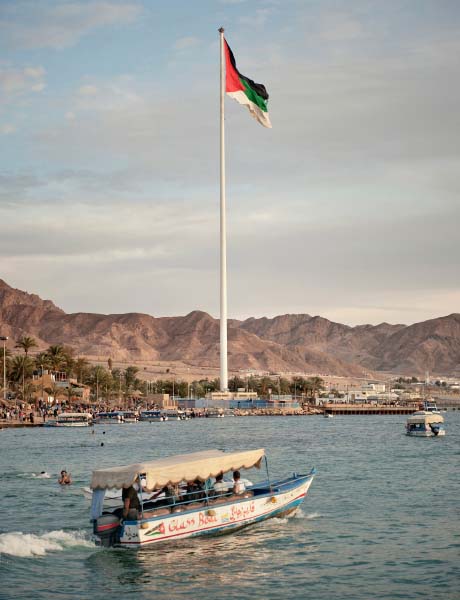
Jordan’s window onto the Red Sea is just 27 kilometres of coastline
36. Yet another reason to visit Petra
A new museum has opened at the astonishing UNESCO World-Heritage site Petra – the ancient city famous for its unique architecture carved directly into the largely sandstone cliffs in the ravines and canyons of southern Jordan.
The Petra Museum was five years in the making and complements the sprawling archaeological site that was lost to the Western world for around five centuries by providing visitors with more insight about its magnificent ruins: from the emergence of the mysterious, once-nomadic Nabateans – who created one of the most astonishing prehistoric civilisations but about whom not much is known – to the sophisticated engineering that supplied water to the desert city. Carve out at least two days in your Jordan itinerary to do the vast site of Petra, and its new museum, proper justice.
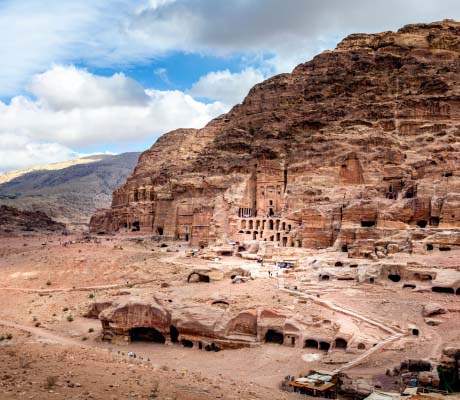
Petra has an uncountable number of reasons to visit
37. Otherworldly Oman
My wife and I are the only two people bobbing in the sea along an expansive two-kilometre stretch of beach. Crabs are building sandcastles, and the only sound comes from the water gently lapping around us. Below the surface, fish occasionally dart past, their dark eyes standing out in the piercingly clear waters.
Turning to face the beach, a steep arc of jagged cliffs encloses the scene, creating a cocoon for the sand and sea. At either end, sheer mountains slice into the water, emphatically marking the line where the water world ends and land’s dominion begins.
A crimson mist, portending dusk, slowly darkens to violet then purple. The call to prayer echoes across the bay, providing a fitting soundtrack to this stark and evocative landscape.
This is Oman – or to be precise, Zighy Bay on the Musandam Peninsula, an unusual slice of land isolated from the rest of the country by the United Arab Emirates.
After a two-hour drive from Dubai (it takes nearly six hours from the Omani capital of Muscat), we spend the last 10 minutes of our journey in an almost vertical climb, eventually stopping at a mountaintop lookout to absorb the view of the bay below.
Two villages are squeezed between the cliffs and the beach, their squat structures of sandy stone punctuated by ubiquitous date palms. Our driver asks whether we would like to tandem paraglide to check in; Six Senses Zighy Bay is that kind of resort. We choose four wheels instead of two wings.
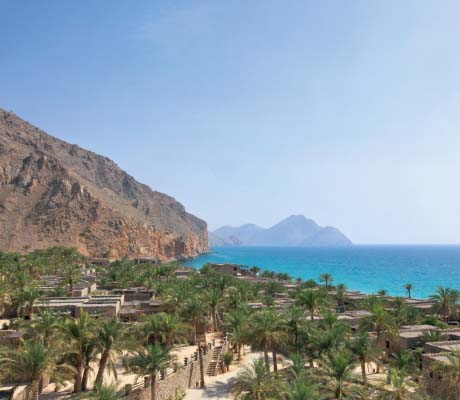
The otherworldly beauty of Oman
38. The many merits of the Abu Dhabi Edition
Technically a chain hotel, the Abu Dhabi Edition is link number 10 in a scrupulously crafted micro-chain of boutique hotels in kicking hoods in places like West Hollywood, London and Bodrum (Turkey). A bird’s nest-ish white concrete lattice outer frame cloaks the edges of its two glass buildings – 198 hotel rooms and 57 serviced residences. It’s a patent foil to the cluster of skyscrapers across the emerald waters of Al Bateen Marina, one of Abu Dhabi’s more lively areas.
In a city not renowned for its design-led hotels, the Edition’s five-storey lobby is a foxy masterstroke of first impressionism; the irrefutable nucleus of this collaboration between boutique hotel guru Ian Schrager and Marriott International.
But don’t expect a hyper-mercurial Manhattan nightclub aesthetic from the man who was partly responsible for the once-exalted Studio 54. The lobby (actually, the entire hotel) has been labelled as minimalist; perhaps by those who’ve only given it a superficial glance.
At every point, the Edition’s staff are finely honed, bubbly, knowledgeable, familiar and chatty – almost too much so for a true introvert, but with Champagne-bucket-loads more personality than the overly stiff service that’s often associated with five stars.
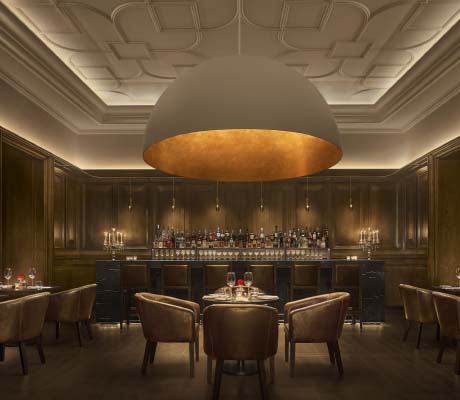
The Edition’s five-storey lobby is a foxy masterstroke of first impressionism
39. Get to know Sharjah
The little-known emirate Sharjah – just half an hour north of Dubai – is something of an antidote to the gleaming skyscrapers of the region. It’s known to the art world for the Sharjah Art Foundation and its biennale but – despite laying claim to the UAE’s first airport – it hasn’t traditionally been on the traveller’s road map as far as a stop-over is concerned. But things are changing. Today, it’s considered the nation’s cultural capital, with the emirate’s largest and most ambitious historical preservation project at its centre. The Heart of Sharjah project aims to preserve and restore the old town of Sharjah and return it to its 1950s state.
A vital part of this project is Al Bait Sharjah, a Leading Hotels of the World property managed by GHM hotels that’s the sister property of Oman’s Chedi Muscat and the emirate’s first luxury resort. Converted from a collection of historic manor houses, Al Bait is an exercise in heritage revival with optimum elegance: its labyrinth of 45 rooms (replete with teak four-poster beds), restaurants, spa and wellness facility set around a series of beautiful quiet courtyards made for lounging and luxuriating in. Its name does translate to ‘Welcome Home’, after all.
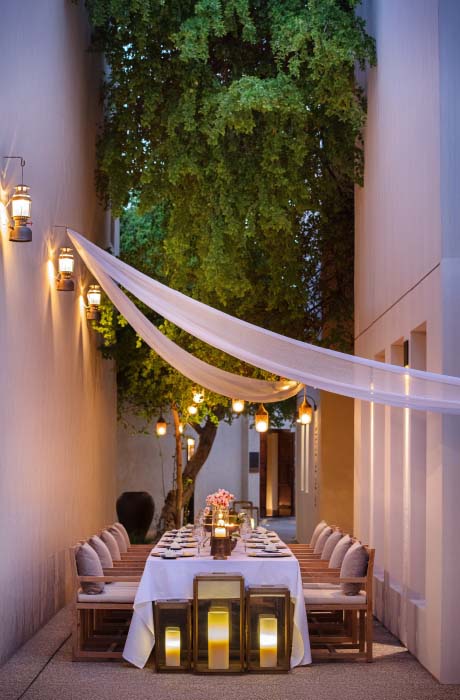
The little-known emirate Sharjah is just half an hour north of Dubai
40. A museum worth stopping over for
Good design is worth going out of your way to see; so it doesn’t seem so outlandish to book a flight for the included 21-hour stop-over in order to see outstanding design, right? That’s the option travellers transiting through the Qatari capital of Doha have so they can stand in wonder at the new Qatar National Museum.
The vision of French Pritzker Prize-winning architect Jean Nouvel, the building is made up of a series of mammoth luminous cream discs that slot together to resemble a desert rose, the name given to clusters of gypsum and sand that form in arid desert landscapes. While the exhibits inside are compelling, standing dwarfed by Nouvel’s exquisite design as the unrelenting desert sun makes it glow bright is a sight well worth the long haul.
Deals
Fifth leg: The Middle East to Europe
41. Hit the Iranian slopes
It may be an utterly unlikely alpine destination that some will consider a snow-go zone, but Iran’s brilliant Alborz Mountains in the country’s north are just beginning to realise their vast skiing and snowboarding potential. For beginners and sightseers, head to the elfin (but high above the tree-line) resort of Tochal, an easy day trip way, way up from the capital, Tehran.
About three snaking hours’ drive north, Dizin is the pick of the more serious-skier options. Here you’ll find middle-class Iranians shredding the relatively laid-back resort’s varied, sometimes-challenging terrain, serviced by gondolas that look like ’70s Bond film props, and probably date back to the days of the Shah. Iran’s some-would-say-oppressive cultural restrictions seem less policed in the resorts; although good tea and sweets are as far as après-ski goes (alcohol is illegal), and ski schools are gender-specific.
42. The door to hell is open in Turkmenistan
If glimpsing a passage to the underworld sounds like your ideal holiday, you’ll want to get yourself to Derweze, Turkmenistan. Locally dubbed ‘The Gates of Hell’, the Darvaza gas crater has been a veritable ring of fire for decades – ever since an ill-fated mission to hunt for oil by Soviet scientists in the ’70s resulted in the collapse of a gas pocket into an underground cavern, taking their drilling equipment with it. Apparently no scientists were injured in the collapse, but over the years there have been reports of hordes of spiders cascading into the flames below. A nightmarish scene, if ever there was one. Despite this, the crater in the Karakum Desert continues to lure the pyro-curious each year.
43. Sheki is the jewel of Azerbaijan
A beautiful small city at the foot of the Greater Caucasus Mountains in north-west Azerbaijan, halfway between the country’s capital Baku and Tbilisi in Georgia, Sheki was once an important stop on the ancient Silk Road. This hive of craftsmen and merchants was made rich by silkworm-breeding and silk cocoon-trading in the 18th and 19th centuries, and the recent UNESCO World Heritage listing of its historic centre placed it firmly back on the map.
Influenced by diverse building traditions of the Safavid, Qadjar and Russian empires, the city’s traditional architecture is expressed through its ensemble of houses with high gabled roofs and gracious caravanserai – one of which you can stay in. Encompassed by the heritage listing is the Khan Palace, the summer residence of the Sheki Khanate built in 1762. Showcasing the ancient art of ‘shebeke’, intricate wooden lattices inlaid with stained glass and fitted together without glue or nails, it’s a glittering sight to behold.
44. The big but quiet airport
With seemingly little fanfare, Turkey opened the first phase of what will be the biggest airport in the world last April; fully completed it will be able to handle 200 million passengers a year. The US$12 billion Istanbul Airport features a striking tulip-shaped control tower (the tulip is a symbol of power in Turkey), and a 451-room Yotel with both ‘land-side and air-side’ access.
Huge floor-to-ceiling glass walls let plenty of natural light into the terminal, which has sculpted white, curved ceilings and arches that recall the city’s mosques. What we really love, however, is that unlike the frantic bustle and chatter of other big international airports, Istanbul’s has been designed to be a quiet place with no ambient music and hushed acoustics to make it a welcoming, calming space for weary travellers.
45. Crete: the isle of wonder
Crete is the largest of the Greek Islands, its rugged and varied terrain heavy with history and mythology (the Ideon Cave located on Mount Ida is celebrated as the birthplace of Zeus). In addition to his comedic turns, Andreas is one of the island’s leading expert guides regarding the Battle of Crete.
Over the years he has taken many visiting veterans to local war graves, reliving their days on the island during the four-year German occupation. We visit the hill where New Zealand General Bernard Freyberg was able to see German paratroopers begin the airborne invasion of Crete on the morning of 20 May 1941. The resulting battle lasted 10 days. The beautifully manicured Commonwealth War Graves cemetery at Suda Bay, and the historic Greek Orthodox Moni Toplou monastery in Sitia. The monastery dates from the 14th century and houses priceless religious icons and elaborately embroidered altar vestments
The white sandy beach at Vai calls for a quick dip and a lunch of exemplary moussaka washed down with a glass of local rosé. Another memorable day is spent on an eco-farm that still proudly farms using traditional methods. They grow their own artichokes, tomatoes, olives for oil, grapes for wine, and shear their own sheep, spinning the wool. They also show us how to make a simple cheese
On the north-west coast of the island, we dine at Stavros Beach where Anthony Quinn famously starred in Zorba the Greek, and wander the marketplace of Chania, a picturesque town of narrow streets and quaint waterfront restaurants. We admire the lovely old Venetian port of Rethymno and get lost in its atmospheric old town. One day we take a ferry to the small island fortress of Spinalonga, built by the Venetians in the 1600s. It became a leper colony in the early 1900s, accommodating some 450 people before antibiotics finally put it out of business in 1957.
However, by far the island’s biggest tourist attraction is the celebrated Palace of Knossos, the former capital of Minoan Crete that ruled southern Europe 4000 years ago.
Andreas says there is still so much of the island’s history to be uncovered, and believes that if they were able to develop the area around Gortyna – the capital of Crete during Roman times – it could be turned into the “Ephesus of Crete”, connected to the footsteps of the Apostle Paul, who landed there in the first century AD. Boreí kápoiaméra – maybe someday.
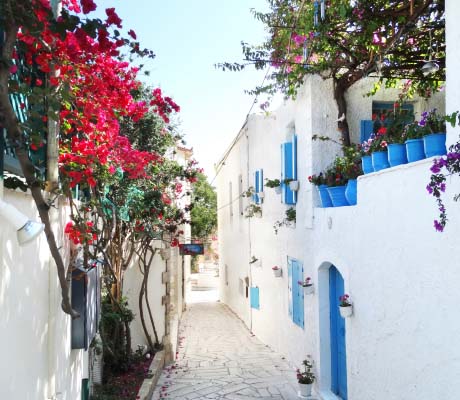
Crete is the largest of the Greek Islands
46. Magnificent Malta
It’s inexplicable exactly why Malta seems to be the most overlooked destination in the Mediterranean, when compared to the likes of Italy and Spain. Idyllically situated between Sicily and the North African coast, the archipelago is made up of three islands, Malta, Gozo and Comino, with a population of fewer than 500,000 people spread across them.
What it lacks in people it makes up for in just about everything else, with stunning beaches, endless sun and 7000 years of history to wonder at – everyone from the Phoenicians and Romans to the British have all left their mark here. While Malta is the cultural heart of the country, Gozo has a much more languid, rural pace. As for Comino, there is one hotel and not a lot else, except stunning blue water and not-another-person-in-sight expanses to explore.
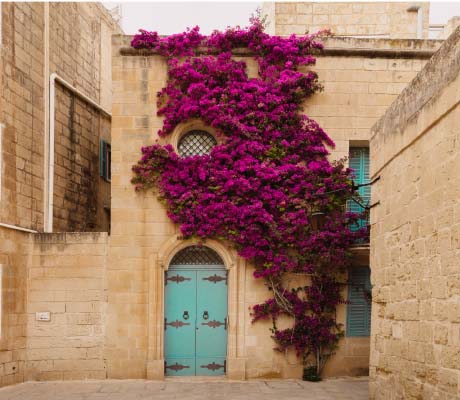
Malta is one of the most overlooked destinations in Europe
47. Coffee and culture in Rijeka
The Croatian coastal city of Rijeka will next year assume the mantle of European Capital of Culture (an honorific it will share with Galway in Ireland), but for those of you scratching your head and wondering why you have never heard of the place, allow us to enlighten you. The city is the third largest in the country after Zagreb and Split, and its strategic position on the Adriatic meant it was much tussled over throughout the years, coming under Habsburg rule in the 1400s and being plundered by the Venetians in 1509. In 1804 it became part of the Hungarian Empire, and it was during this time that the gracious architecture that can be found along the main thoroughfare of Korzo was completed. Today Rijeka is a bustling port city with abundant historic sites, from Roman ruins to the 13th-century Trsat Castle, a lively cafe culture and a year-long program of events aimed to promote and encourage cultural diversity that are sure to put it on the map.
48. Hungary’s wine scene is on the rise (again)
Hungarian wine might not have too much of a profile in Australia, but it has serious heritage. Twenty-two historic wine regions are spread across the country’s bucolic landscape, and the sweet drops produced by its most famous, Tokaj – in the business since the 15th century – were once prized throughout Europe: Louis XIV declared them the ‘wine of kings, king of wines’.
A series of events including the phylloxera epidemic that devastated Europe’s wine grapes in the late 19th century and two world wars saw its reputation greatly diminished by the end of the 20th century, but a new wave of Hungarian winemakers has been restoring it to its former glory over the past few years. Take a tour around regions including Tokaj, Eger, Villány, Somló and those near Lake Balaton, or settle into one of Budapest’s many wine bars – including hidden Galéria12, homespun Doblo and buzzing DiVino – to sample a healthy cross section.
49. Palazzo living in Puglia
Puglia has been luring an ever-increasing number of visitors to its rugged landscape, picturesque villages and towns and gentle pace of life over the last few (northern hemisphere) summer seasons. And now it has a design hotel befitting its hotspot status. Located in the small town of Gagliano del Capo, Palazzo Daniele’s nine rooms are housed in an imposing aristocratic palazzo built in 1861.
Having housed four generations of the Daniele family, current owner Francesco Petrucci decided to turn the palazzo into a retreat for artists from all over the world, working with Milan-based designers Ludovica and Roberto Palomba to strip the house back to its bones so that its beauty and history could shine through. Then, after a conversation with his friend, art collector and hotelier Gabriele Salini (responsible for G Rough Rome), the decision was made to open the property as Palazzo Daniele. A member of Design Hotels, the property boasts nine suites, charming courtyards, a pool and a rotating roaster of art on its monastically stark walls.
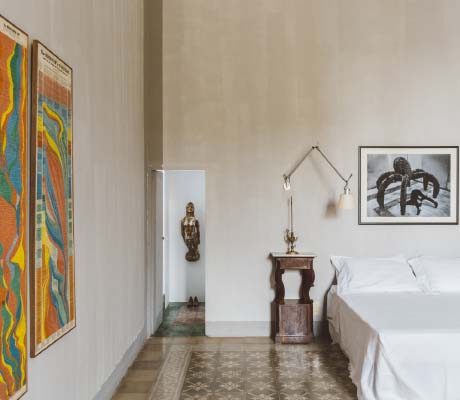
You’ll find Palazzo Daniele in the small town of Gagliano del Capo
50. Drink Prosecco in Prosecco
What’s next for the oenophile who has quaffed Champagne in Champagne and Chianti in Chianti? How about Prosecco in Prosecco? It’s perhaps no surprise that the Bellini – a cocktail made with Prosecco and peach purée or nectar – was invented in Venice when you consider the key ingredient is made just an hour outside the city in the Treviso region. The Prosecco hills of Conegliano e Valdobbiadene have recently been added to UNESCO’s list of World Heritage sites for the distinctive way they have been farmed since the 17th century. Consider a sparkling wine tour from Venice to take in a rustic landscape dotted with traditional Italian villages, where vines cling to undulating hills across over 100 (mostly family-run) wineries.
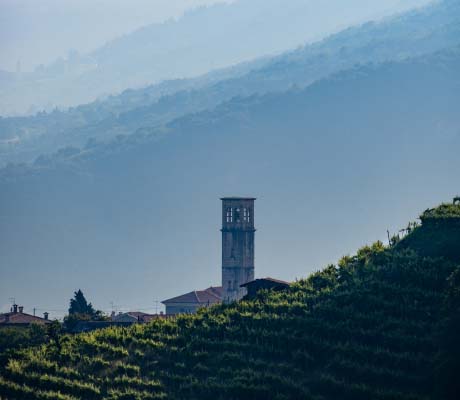
Drink Prosecco in Prosecco
Deals
Sixth leg: Europe to the UK
51. The ski lodge just got glam
Lefay Resort & Spa Dolomiti. This achingly glamorous ski resort in the Italian Dolomites is going directly to the top of our luxe list. Staying at this sleek Bond-esque hideout come winter is akin to living in a snow globe – the most idyllic, ice-crusted scenery on display from all vantage points. Designed to harmonise with its woodland surroundings in the UNESCO World Heritage site, Lefay Resort & Spa Dolomiti is a sanctuary for both hikers and skiers, depending on when your visit falls. But we could quite easily spend our entire stay in the 5000-square-metre spa in the pursuit of ultimate pampering goals.
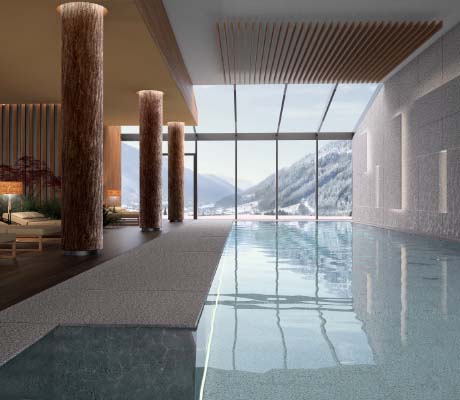
Lefay Resort & Spa Dolomiti: the achingly glamorous ski resort in the Italian Dolomites
52. Menorca is seriously cool
While its sister Balearic islands of Ibiza and Mallorca have long dominated travellers’ attention (arguably to their detriment), Menorca has managed to keep hedonistic dance parties and landscape-blighting over-development at bay, opting instead to nurture sustainable tourism and jealously guard its slower pace of life.
In addition to a collection of beaches that seem to dissolve into impossibly blue waters (in which you can snorkel, dive, paddleboard and sail), the island boasts a gentle landscape perfect for walking and biking. There are quaint towns the likes of Ciutadella (technically a port city), with its evocative old quarter and medieval streets, and an increasing number of interesting accommodation options, including the Menorca Experimental (far left), with its stunning water views and ‘why-can’t-I-live-like-this’ design aesthetic.
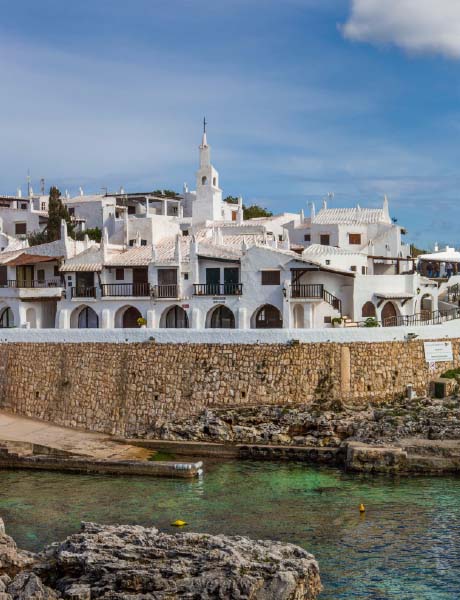
Menorca is embracing a slower way of life
53. The most interesting place to eat in the world?
What’s in the water in Spanish Basque Country? This utterly unique region – with its distinct language, culture and landscape – continues to cement its reputation as one of the world’s most interesting places to dine with each announcement of the World’s 50 Best Restaurants.
This year’s saw the region and its seaside gem of San Sebastián – Donostia to locals – make up 10 per cent of the top 50, including the simple wood-fire barbecue joint Asador Etxebarri in the mountain village of Axpe at number 3; the playful and avant-garde Mugaritz based in a traditional Basque country house outside of San Sebastián at number 7; the architecturally striking and sustainable Azurmendi, serving modern Basque cuisine in the town of Larrabetzu not far from Bilbao, at number 14; and the restaurant, Nerua, housed inside Bilbao’s Guggenheim Museum at number 32.
54. Breathing easy in Lisbon
Portugal’s capital has been the destination de rigueur for a couple of years: its time at the top of travellers’ consciousnesses owing to its strong creative streak, renowned food culture and laid-back atmosphere all wrapped up with irresistible old-timey architecture. But just as things start to cool and another city gets its time to shine, Lisbon goes and announces it’s won the European Green Capital award for 2020, an opportunity to boast of its outstanding environmental credentials to the world.
Among those achievements: 76 per cent of people in Lisbon live within 300 metres of green urban areas; it has one of the world’s largest networks of electric vehicle charging points; and it was the first European capital to sign the New Covenant of Mayors for Climate Change and Energy in 2016. So, Lisbon’s many delights still beckon, and now you can be assured that you’ll be experiencing them with a dose of clean city air to boot.
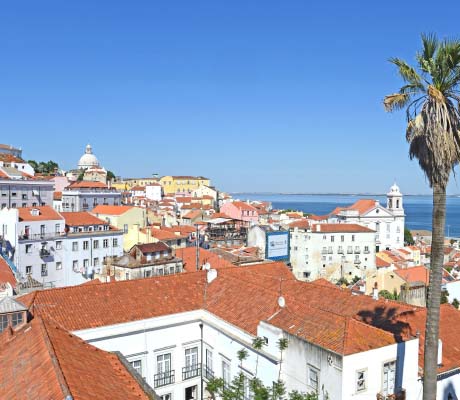
Lisbon is boasting new and outstanding environmental credentials
55. Eat your heart out in Lyon
Lyon has long been France’s beating culinary heart, or rather, its stomach. If you love to eat, follow the well-beaten path of chefs and critics who flock to this charming city set amid fertile agricultural land.
Dubbed ‘the world capital of gastronomy’ in 1935 by French food critic Curnonsky, and home to culinary legend Eugénie Brazier, the first chef to be awarded six simultaneous Michelin stars and who is credited for mentoring famed chef Paul Bocuse, Lyon has serious food-nerd credentials. Now there’s another reason to explore the city’s gastronomical landscape with the opening of the Grand Hôtel-Dieu. This architectural gem largely operated as a hospice since its foundations in the 12th century, but after closing in 2010, the stunning building was attentively restored and now houses a five-star InterContinental hotel, a food market and an array of incredible eateries. A good place to begin an excursion of indulgence in the city.
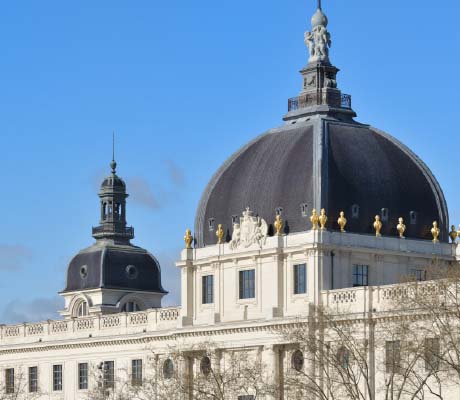
Sample some culinary delights in Lyon
56. Da Vinci does the Louvre
It’s been 500 years since original Renaissance man Leonardo da Vinci died in France, and the Louvre – which holds the largest collection in the world of his paintings, plus 22 drawings – is commemorating this anniversary with a blockbuster exhibition, named simply Leonardo da Vinci.
It runs between 24 October and 24 February and a timed-ticketing policy has been introduced in anticipation of high demand. The exhibition will gather as many of the artist’s works as possible around the five masterpieces (The Virgin of the Rocks, La Belle Ferronnière, Mona Lisa, Saint John the Baptist and Saint Anne) in its collections.

Da Vinci does the Louvre
57. Cheap and chic
While there’s no denying the allure of a five-star hotel (followed closely by a design-driven boutique one), getting something for next to nothing has its virtues too. Hence the rise and rise of the well-priced, design-conscious accommodation category.
Banish all images of sagging bunk beds and iffy shared bathrooms, the likes of Generator and Mama Shelter, both of which have an ever-increasing rollcall of properties across Europe, are funky, fun-filled spaces that combine quirky style with budget category-busting inclusions like restaurants, bars and en suites. While they do tend to skew toward the 18–28 demographic, their democratisation of good design at a reasonable price means no one is turned away just because they tick a different age box.
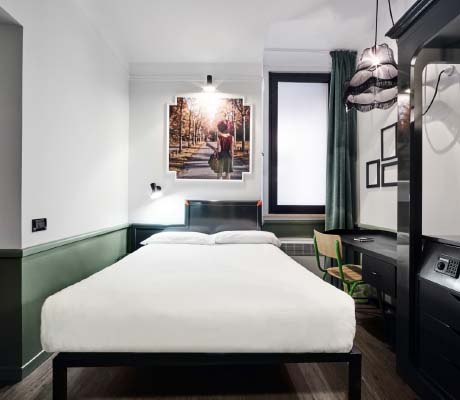
Generator is upping the hostel game
58. The pearl of the Alps
Skiing isn’t simply about good conditions and endless runs, it’s also about a strong sense of culture wrapped up in the beauty of snow-covered mountains. The village of Saas Fe, nestled deep within the Swiss Alps is about as quaint a ski resort as you’re likely to find anywhere and dripping in authentic Swiss mountain culture.
There are no cars allowed here – if you want to get somewhere quick then hop on a toboggan; the hotels are housed in grand old Swiss mountain chalets and run activities like alphorn-blowing and yodelling to give guests a sense of mountain tradition (stay in the great family Hotel Alphudel); and beyond the rustic cow sheds and pretty snow-covered lanes, Sass Fe is positioned at the base of a vast glacier that pours down from a ring of dramatic peaks. It’s no wonder the Swiss refer to Saas Fe as ‘the pearl of the Alps’.
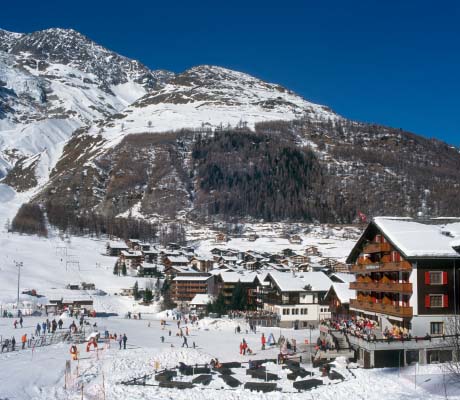
Skiing is about so much more than just the snow
59. Ancient innovation in Augsburg
Augsburg in Germany’s southern state of Bavaria is not only one of the country’s oldest cities, but also one of its most attractive, with a bounty of eclectic architecture in its old town that encompasses medieval guild houses, an 11th-century cathedral and an onion-domed abbey. But what makes the city especially fascinating are the technological and social innovations of the past that have had a lasting effect.
The city’s historic water management system, which has evolved in successive waves since the 14th century and includes a network of canals and water towers developed from the 15th to 17th centuries, continues to provide sustainable energy today and has this year earned itself a UNESCO world-heritage listing. And the city’s Fuggerei is the world’s oldest social housing complex still in use: a perfectly preserved walled neighbourhood where rent – $1.50 per year – hasn’t increased since 1520. Its 150 or so Roman Catholic residents are required to pray three times a day as part of this gobsmackingly good deal.
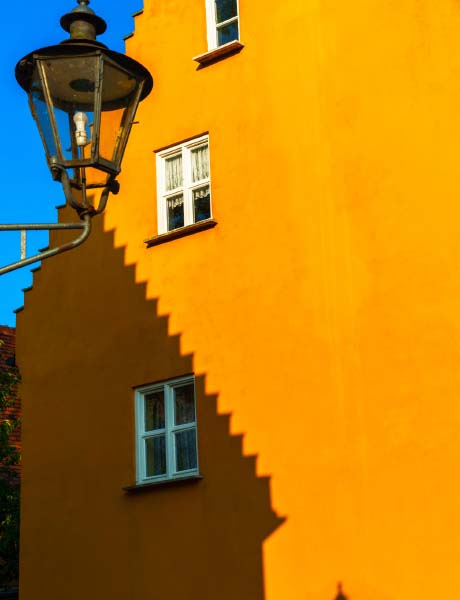
Old meets new in Augsburg
60. The pinnacle of design in Dessau
A small industrial city in eastern Germany, Dessau is strongly associated with the modernist Bauhaus movement that became one of the most influential in the 20th century and led to the development of modern art in Europe and the United States.
This is where the school of design founded by Walter Gropius in Weimar in 1919 was active for the longest period of time, and where it experienced its most creative period from 1925 to 1932; today you’ll find the highest concentration of structures from this period here than anywhere else in the world. You can still visit the heritage-listed main building for the Bauhaus school designed by Gropius in 1925 as well as others associated with it including the newly restored Kandinsky/Klee Master House. And to coincide with 100 years since Bauhaus was founded, a new museum – Bauhaus Museum Dessau – has just been opened.

Dessau is strongly associated with the modernist Bauhaus movemen
Deals
Seventh leg: The UK to Scandinavia
61. London hits a (MILLENNIAL) PINK patch
If there is a colour that encapsulates the mood of London it is millennial pink. The rosy, happy hue is the go-to colour of everything from the walls to the furniture within The Gallery, the plush dining room inside sketch, the celebrated Mayfair restaurant-cum-bar-cum-art space. Accessed by a staircase drenched in oozing pink paint, the room is an absolute delight to behold, with its bulbous tulip-shaped chairs and numerous David Shrigley artworks lining the walls; classic afternoon tea is served here seven days a week.
Meanwhile over in Chelsea, the latest eatery to arrive on the King’s Road is Humble Pizza, a vegan pizza joint whose stylishly minimalist interior, and everything in it, is kitted out in pink, including the takeaway boxes.
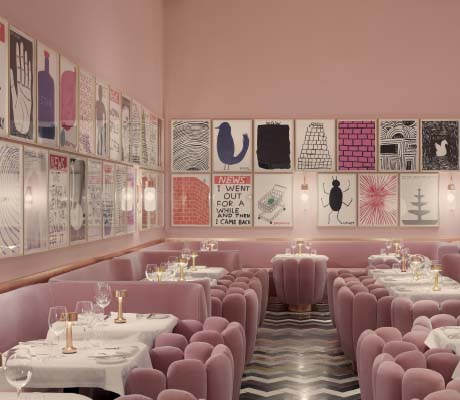
Think PINK at Sketch London
62. Buy the book (and the bag)
If we were to use the logoed, reusable canvas bag as a litmus test of popularity, Daunt Books might just be the most frequented store in London. Its flagship outlet occupies a grand Edwardian space (originally built in 1910 for antiquarian booksellers Francis Edwards) on Marylebone High Street.
You’ll find new-release titles lovingly displayed on round tables and a grand staircase that leads up to a shelf-lined gallery where you can browse to your heart’s content. And when you finally find the perfect read, make sure to spend the extra to have it packed into one of the aforementioned bags, the ultimate in-the-know status symbol.
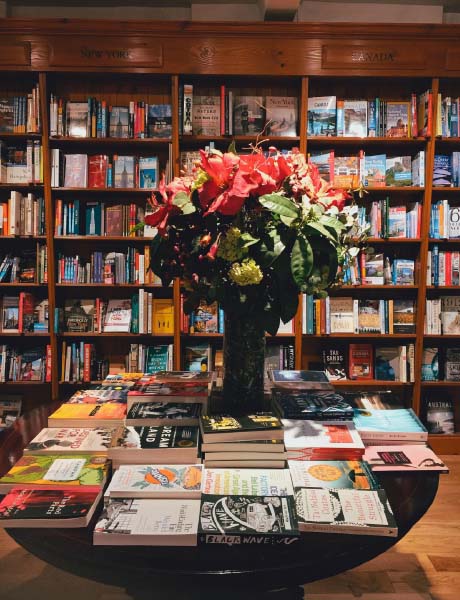
A book store for the ages
63. London goes REALLY wild
Yes, Britain has a brand-spanking-new national park and a big one at that: London. Lower those eyebrows, although you could be forgiven for raising them; England’s capital is the first in the world to be designated a National Park City. The initiative saw the mayor and various organisations sign a charter to demonstrate a commitment to make the city greener, celebrating and expanding its wild spaces and fostering the surprising wildlife that calls London home, including bats, foxes and hedgehogs – in fact there are 15,000 different species to be found. So if you’re a national park hound you now have another surprising entry to tick off your list.
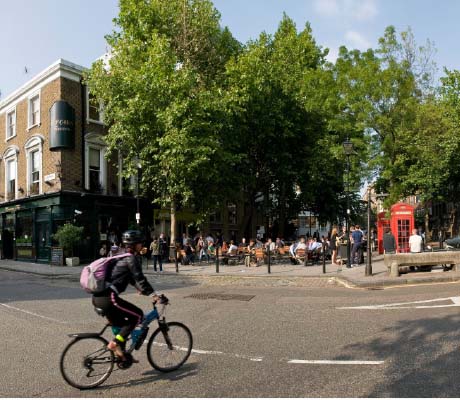
England’s capital is the first in the world to be designated a National Park City
64. Riding the rails in Europe
There are droves of Europeans, and the occasional international tourist no doubt, who are eschewing the lure of cheap flights to hop from city to city, and rediscovering the pleasures of train travel instead.
The rail renaissance could be ascribed to 16-year-old Swedish climate activist Greta Thunberg, the one who isn’t interested in meeting President Trump and recently sailed the Atlantic to attend a UN climate summit. Early in 2019 she toured Europe by rail to highlight the benefits of fast, efficient and clean rail links and others are following her lead to emit roughly 90 per cent less CO2 by rail compared with flying (according to Eurostar). It may be tempting to hop on an EasyJet flight from Gatwick Airport to get to the next leg of your European odyssey, but why not head to the refined period glamour of St Pancras International instead, enjoy a glass of Champagne at Fortnum & Mason, before being whisked into the French countryside by train?
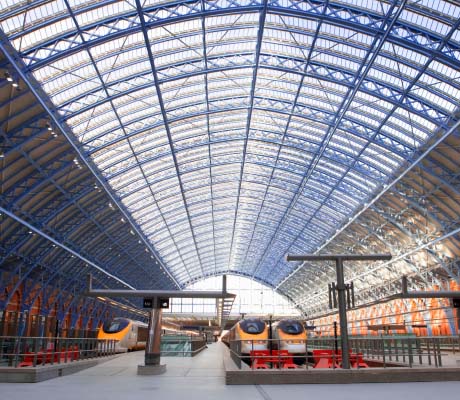
Ever dreamed being whisked into the French countryside by train?
65. 24 hours in York
For those with only a cursory knowledge of the English city of York, you probably know about York Minster, but after that the details get vague. But the fact is that York has so much more to offer the first time visitor, and the best bits can easily be done in a day. Here are the highlights.
• The first place to head to get a true grasp of just how old York is, is The Shambles, a narrow cobbled street lined with timber-framed buildings, some dating back to the 14th century. While its name seems to reflect the higgledy-piggledy nature of the shops that are squeezed into the space, it actually derives from the butchers’ shops that were once located here. These have long been replaced with magic shops as the street is believed to have been the inspiration for Diagon Alley in the Harry Potter series.
• Your next stop should definitely be York Minster, the magnificent medieval Gothic cathedral (the largest in northern Europe) that lies at heart of the city. Spend some time gazing up at the elaborate carvings on the outside and opt to climb the Central Tower for stunning views out to the Yorkshire countryside.
• York is famous for its chocolates and sweets (KitKats were invented here), and the streets are lined with stores selling biscuits, toffees and other treats – perfect souvenirs for friends and family.
• Head to the The Quarter, the historic and current commercial hub of the city, to browse the stylish shops and sit down to a traditional afternoon tea: Bettys Cafe Tea Rooms is a Yorkshire institution.
• You can work off the scones by taking a walk along the 3.4-kilometre city walls: the entire circuit takes about two hours to complete.
• As night falls, head back to The Quarter to join one of the guided ghost tours that snake their way through the dimly lit streets and alleys, hearing gruesome tales from York’s long and colourful history.
• Finish the day with a typical dinner of Yorkshire pudding and juicy pork which come rolled into a famed YorkyPud Wrap at The York Roast Co.
66. Stay in a vegan hotel
Designed to cater to ‘vegans, vegetarians and the plant curious’, Saorsa 1875 is the UK’s first totally vegan hotel. Located in the pretty town of Pitlochry in Perthshire, the hotel consists of 11 rooms housed within a 19th-century baronial manor, each one individually designed and featuring antique furniture, luxurious linens and 100 per cent vegan toiletries. Of course, there’s a restaurant serving a vegan menu that showcases organic and ethical ingredients sourced either from the on-site garden or local farms, as well as a bar, Faodail, where the mixologists serve up unique blended cocktails as well as Scottish craft beers and small-production wines.
67. The fife arms, Braemar
Times were when visitors stopping off in the charming Scottish village of Braemar would be looking for a cup of tea and a toasted haggis sandwich (yes it’s a thing) after visiting Balmoral Castle, the Queen’s holiday home down the road. But since The Fife Arms opened late last year, you’re more likely to run into A-listers enjoying a weekend idyll or Edinburgh types waiting for a table at the permanently packed restaurant.
A former Victorian coaching inn, it took four years of renovations to transform the grand but dull edifice and interiors into one of the hottest hotels in Britain. A mesmerising mash-up of fine art (there are works by Picasso and Lucian Freud in the lobby), tartan walls, taxidermy, antiques and objects, there are 46 individually decorated rooms, including the Royal Suites, complete with four-poster beds and free-standing copper baths, and an Artist’s Studio with its hand-painted walls. Downstairs there’s The Flying Stag bar, The Clunie Dining Room and The Drawing Room, with its overstuffed lounges and ceiling artwork by Chinese artist Zhang Enli. The overall effect is over-the-top yet perfectly balanced and definitely worth staying longer than it takes to polish off a haggis sandwich.
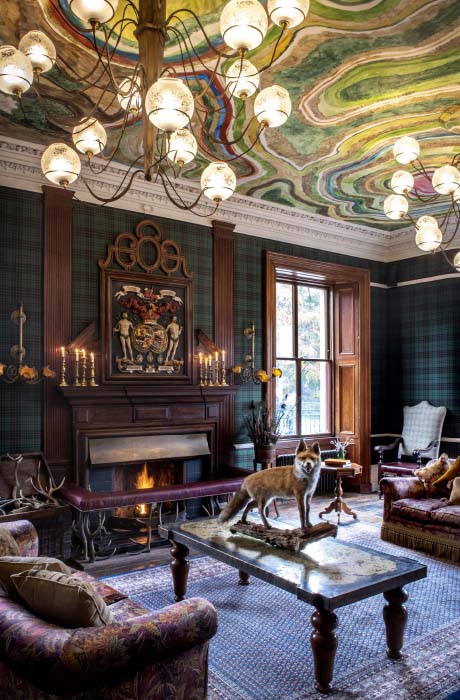
The Fife: Braemer’s permanently packed restaurant.
68. A match made in heaven (AKA the West Coast of Ireland)
Singles, forget Tinder and hightail your way to Ireland’s west coast town of Lisdoonvarna for a 178-year-old matchmaking festival. Run by Ireland’s very own Cupid, Willie Daly, who has been matchmaking for more than 50 years, the quirky event started out as a way for lonely rural farmers to find wives. Today, the month-long festival draws in people from around the world to enjoy live music and dancing, speed-dating, daily matchmaking by Willie himself, and a dedicated LGBTQI weekend. And if you’re unlucky in love, at least there’ll be some craic (good times) to be had.
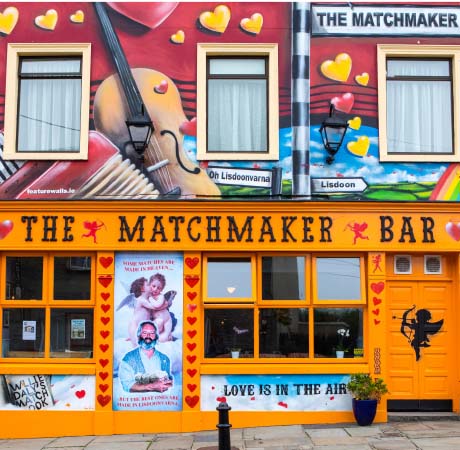
Forget tinder, head to this matchmaking town
69. The happiest places on Earth
Move over Mickey. The Land of the Midnight Sun has been named The Happiest Place on Earth for the second year in a row as part of the UN’s 2019 Happiness Report (which is based on income, freedom, trust, life expectancy, social support and generosity).
Finland is known for its vast landscapes of forests, lakes and snow-blanketed polar regions, the awe-inspiring Northern Lights, Santa Claus, and emerging design and culinary scenes. Travellers can sleep in a glass igloo under the stars, hike through vast wilderness in one of 40 national parks, be pulled along by huskies on a sleigh ride, and relax in a Finnish sauna before jumping into an icy lake! Finland was closely followed by Denmark, Norway and Iceland, proving the inhabitants of this Nordic region truly are on top of the world.
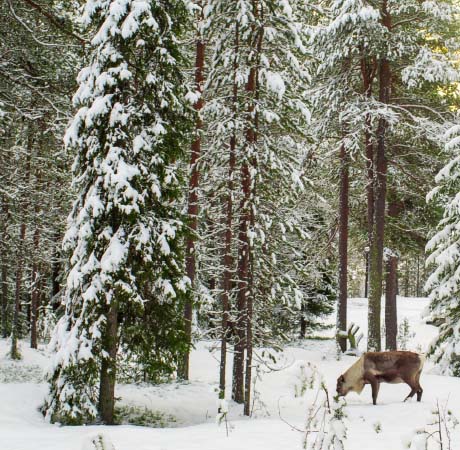
The Land of the Midnight Sun has been named The Happiest Place on Earth for the second year in a row
70. Geranium versus Noma
While the second iteration of Copenhagen’s Noma might retain the title of second best restaurant in the world according to the World’s 50 Best Restaurants 2019, it faces stiff competition from Geranium – which this year sits at number five. The restaurant opened in 2007 and has climbed all the way up the list from 49 in 2012; it’s also Denmark’s first and only Michelin three-star restaurant (Noma has two stars).
But they are two different dining experiences. While Noma has bedded into its new location on Copenhagen’s up-and-coming industrial island Refshaleøen with René Redzepi still at its helm, Geranium is incongruously housed on the eighth floor of a national soccer stadium with leafy views over Fælledparken (Common Gardens) and is led by Rasmus Kofoed, who previously won the title of best chef in the world according to the prestigious Bocuse d’Or competition. Settle in for a progressive tasting menu of 17-plus creative courses made from organic and wild Scandinavian ingredients, and be sure to ask for some assistance with the 2500-bottle-strong wine list.
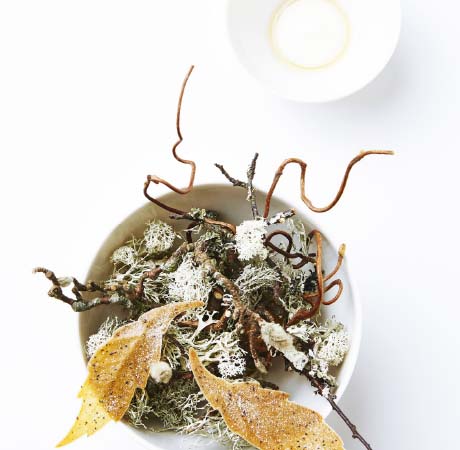
Eat at two of the world’s best restaurants in Copenhagen
Deals
Eighth leg: Scandinavia to North America
71. There’s more to Swedish food than meatballs…
For most of us, the extent of our Swedish food knowledge begins and ends at IKEA. We’ve all eaten the requisite meatballs and bought a jar of lingonberry jam out of curiosity, only to have it surpass its use-by date unopened. But Denmark, with its famed Noma, isn’t the only Scandinavian country to be riding the new Nordic culinary wave. From Stockholm to Malmo and as far-flung as Jamtland, Swedish food is turning heads and watering mouths.
Magnus Nilsson of Michelin-starred Faviken is perhaps the most renowned Swedish chef, but Mathias Dahlgren and Daniel Berlin join him in aligning the (Michelin) stars in the country’s food culture. But it’s not simply fine dining where the Swedes are gaining ground, there is a general movement towards locally sourced, sustainable and honest food made with traditional ingredients that is well worth exploring. A walk through the country’s food markets and sleek city eateries will reveal a… ahem… smorgasbord of local delights.
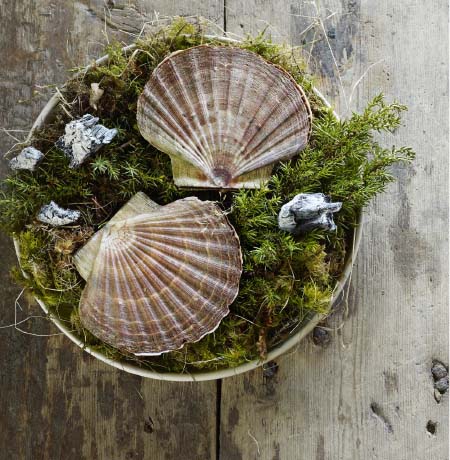
Discover a new wave of Swedish food
72. What you should know about Pskov
Architecture buffs should add Pskov to their bucket list, a city in north-west Russia that’s 30 kilometres from the Estonian border and lays claim to the largest stone fortress in Europe. First mentioned in ancient texts from the ninth century, Pskov is one of Russia’s oldest cities and during the Middle Ages was the wealthy capital of its own republic that acted as a bridge between Russia and Europe. As a result, it has its own school of architecture that informed the evolution of Russian architecture as a whole for over five centuries, and now 17 of its ancient buildings have been heritage listed by UNESCO. Inspired by the Byzantine and Novgorod traditions, these include churches, cathedrals, monasteries, fortification towers and administrative buildings that date back as far as the 12th century and feature distinctive details such as cubic volumes, domes, porches and belfries.
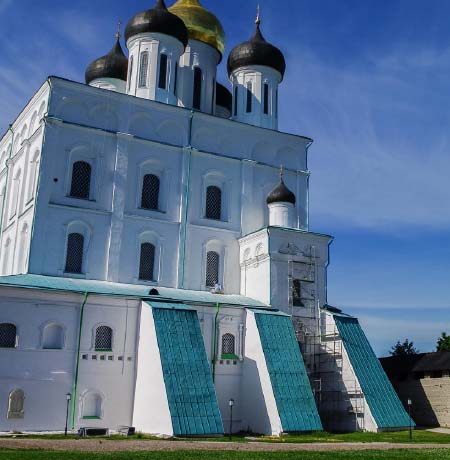
Architecture buffs should add Pskov to their bucket list
73. All aboard the Permafrost Express
If you like to test your extremes and your extremities, jump aboard the Permafrost Express for a visit to Yakutsk, officially the coldest city in the world. Branching off from the Trans-Siberian Railway and travelling deep into Siberia to deposit adventurers at the Nizhny Bestyakh station, on the opposite banks of the Lena River to Yakutsk, the express opens up the city that has, until now, been inaccessible by road.
The considerable feat of engineering was apparently planned in the Tsarist era, and there are vague plans to one day continue the line all the way to America. And what do you do once you arrive in the city built on continuous permafrost? As Russia’s diamond capital, you might pick up a shiny bargain, visit an ice cave or two, and generally revel in the average temperature of -10.4ºC.
74. Walk Iceland’s hot springs trail
Iceland is a country about one and a half times the size of Tasmania with the population of Hobart. Despite the name, it’s quite a green place while nearby Greenland is almost entirely covered in ice. Most of Iceland’s 330,000 people are down-to-earth (even downright blunt) and generally refreshingly unconcerned about presenting a false facade despite the explosion of national tourism since Eyjafjallajökull blew its top in 2010. Like volcanoes, the warmth is there but not always obvious on the outside.
The Southern Highlands, located between Greenland and Norway where the North Atlantic meets the Arctic Ocean, was settled by Celtic monks and pagan Norsemen around the late eighth century, before an isolated population in the tens of thousands somehow survived the volcanic activity, sub-Arctic climate, inherent risks of seafaring and bubonic plague. Old Norse lettering and spelling have also survived – Icelanders today can still read the sagas etched on runestones.
Laugavegur, or ‘the hot spring trail’, begins (or ends, though most people walk north to south) at Landmannalaugar, meaning ‘the hot spring baths of the people’. The trail begins up the side of a volcano that hasn’t erupted for at least half a millennium – a long time by Icelandic standards. Since 1900 there have been more than 50 isolated eruptions from the island’s 30 active volcano systems.
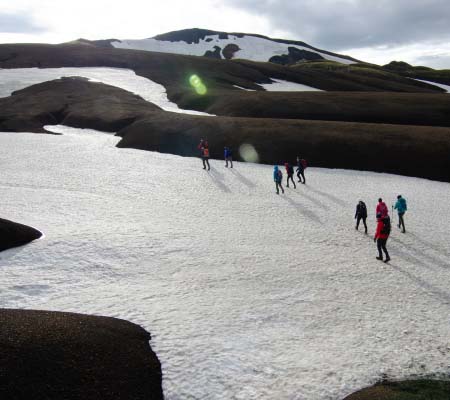
Walk Iceland’s magnificent hot springs trail
75. Priceless Greenland
At the time of writing President Trump was typically showing off his “tremendous” diplomacy skills by offering to buy Greenland from the Danes. The ensuing spat between the rightly peeved Danes and the US has seen Trump cancel a future visit. Cue the Danes breathing a collective sigh of relief.
This autonomous country of the Kingdom of Denmark is a vast, pristine world of endless mountains, immense glaciers and abundant wildlife, a lot of it wrapped up in the Northeast Greenland National Park, the biggest on the planet. Add to that the unique seafaring communities clinging to the frigid Atlantic coastlines in cute fishing villages comprised of multi-coloured houses, and you can see why you need to get there – take a wild journey there with the likes of Quark Expeditions. Sorry Trump, you can’t afford Greenland: it’s priceless.
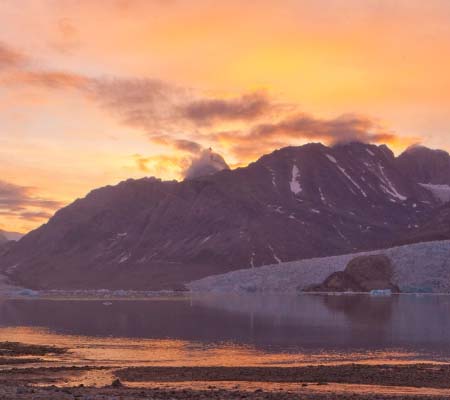
Greenland’s beauty is hard to capture in a photograph
76. The Canadian capital of cool
Cool cafes and bars in Plateau, creative Mile End and hipster-industrial Mile-Ex. The restaurants of Little Burgundy and vintage stores – or friperies –proliferating across the city. Montreal exudes an insouciant and infectious spirit that makes it Canada’s capital of cool. The largest city in Quebec is an intoxicating mix of North American and European culture; be sure to visit in summer when outdoor festivals animate the streets seemingly every week: from fringe to mural art and jazz festivals.
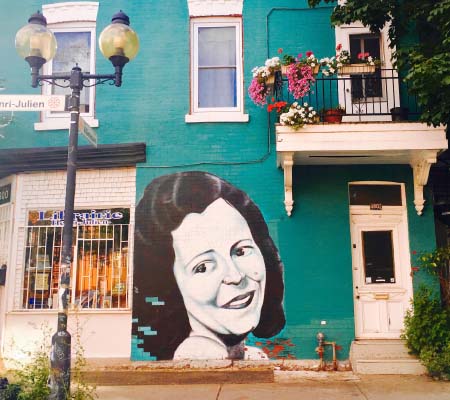
Montreal is Canada’s capital of cool
77. Why Haida Gwaii is amazing
A pristine wilderness of dense rainforests and rugged coastline, Haida Gwaii is an archipelago of 150 islands located off the north coast of British Columbia. Known as Canada’s Galápagos for its abundant flora and fauna, the islands are the traditional land of the Haida, whose ancient totem poles and roundhouses represent some of the oldest examples of coastal First Nation villages.
Isolated by its remote location and the unforgiving weather that prevails here, Haida Gwaii’s solitude has protected it from the ravages of modernisation, meaning that if you do actually make it here you will discover a land of quiet beauty that time has all but forgotten.
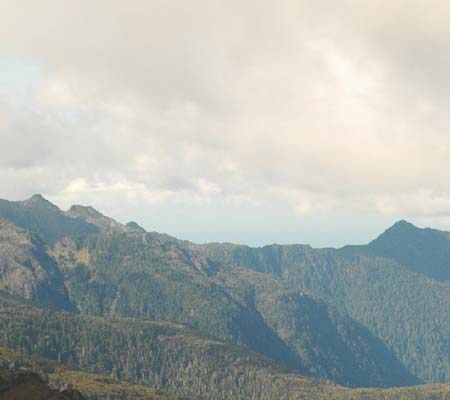
Haida Gwaii’s solitude has protected it from the ravages of modernisation
78. Only the best in New York
The Best Bar in the World is a weighty title to live up to, and this year, according to the prestigious World’s 50 Best Bars list, the burden goes to Dante. Located in New York’s Greenwich Village, the original Caffe Dante opened its doors in 1915 and became a favourite with the local Italian community in the area. Over the years the likes of Anaïs Nin, Ernest Hemingway (is there a bar he didn’t frequent?), Robert Mapplethorpe and Patti Smith drifted in and out. The current owners, Aussies Linden Pride and Natalie Hudson, reopened as Dante in 2015, and again it quickly became a firm favourite with locals.
Crowds flock here seven days a week for its refined yet honest Italian fare (served until late), respectfully modernised interiors (photos of the original owners hang on the walls) and a drinks menu that includes Negronis on tap, a non-alcoholoc Negroni, martinis and spritzes.
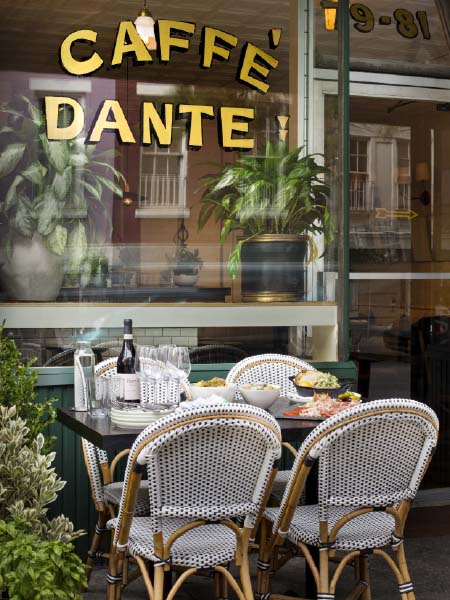
Aussie-owned Dante has topped the World’s Best Bar list
79. The Guggenheim earns its seniors card
A monument to both the talent of architect Frank Lloyd Wright and the aesthetic beauty of modernist design, the Guggenheim Museum turns 60 this year. Named for mining tycoon Solomon R. Guggenheim, whose art collection it was designed to house, Lloyd Wright was commissioned to design a “temple of spirit” where people would come to view art in a new way. He worked tirelessly for 16 years to bring the groundbreaking structure to life, but died just six months before it opened on 21 October, 1959. While traditionalists were critical of the building’s shape and bravado, others viewed it as a masterpiece in its own right. Sixty years on, it still is.

The iconic Guggenheim facade
80. New York state of mind
It sometimes escapes our attention that New York is more than just a city; there is a whole state to explore beyond the limits of the five boroughs. Upstate New York has long been an insider’s secret, the weekend escape of artsy Manhattanites who think the Hamptons has become too glitzy. A new guesthouse in The Catskills is the perfect example of how they do luxury in these parts: Farmhouse Catskills consists of a picturesque 100-year-plus main building, 75 rooms filled with old and new mid-20th century modernist pieces, as well as a farm-to-table restaurant and a bar in the vein of a 1930s speakeasy.
Deals
Ninth leg: North America to Latin America
81. Vermont (the quiet America)
Given the Twitter feeds and television news headlines that blare around the world, it’s easy to get caught up in the blitz of Trump America and its perverse treatment of the truth. Vermont offers an alternative vision: a place where people care about each other, their community and their environment, and where the values are rock solid no matter what the overall political situation might be.
Interestingly, despite all the hysterical sound bites, the values-in-action that Vermont represents are embodied by all kinds of people here, from Brooklyn transplant, Vermont senator and possible presidential candidate Bernie Sanders to prominent Republican families, such as the Rockefellers, Vanderbilts and even the descendants of Abraham Lincoln.
Located south of Quebec, and bordered by New Hampshire, New York State and Massachusetts, Vermont is landlocked, but its long Lake Champlain might as well be the sea, with its various canals linking with New York’s Hudson River and Quebec’s Saint Lawrence River. Three-quarters of the Green Mountain State is forested. In fact, Vermont has more maple trees than people, which means oceans of syrup and spectacular autumn colours.
It has villages with white-steepled churches and green farmland dotted with cows, apple orchards and red barns, not to mention 100 covered bridges and 1000 hiking trails. And let’s not forget fabulous ski resorts such as Killington, Sugarbush, Stowe and the maverick, skiers-only, Mad River Glen cooperative.
But Vermont offers much more than a postcard cliché. It’s always had an independent and progressive streak. Back in the 1800s, it was the first state to abolish slavery and, these days, one of the first to pass marriage equality laws.
Driving is the best way to explore; at the top of your list should be Scenic Byway 100 in the Mad River Valley, with bucolic vistas perfectly framed by the Green Mountains. The first thing you will notice is no billboards; instead, there are street signs for pottery studios and farm stands. Welcome to a slower, more civilised way of life.
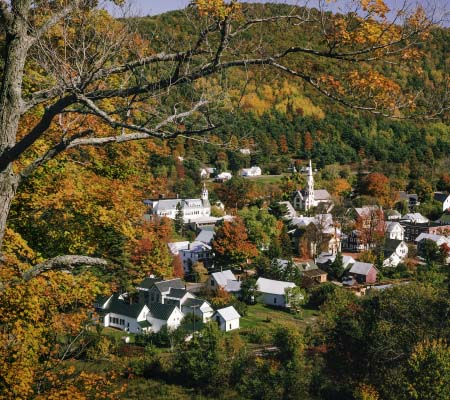
There’s never been a better time to visit Vermont
82. To the moon and back
This year marks the 50th anniversary of one of humanity’s greatest achievements: putting a human being on the Moon. The USA has been celebrating in style, with a scale light projection of the Saturn V Rocket projected onto the Washington Monument on the actual anniversary of the mission, to exhibitions up and down the country.
Wonder in awe at this incredible technical and human feat yourself by bearing witness to an artefact from the mission so treasured, so priceless that it has been kept in a vault at the Smithsonian National Air and Space Museum for 13 years for fear of damaging it. Following a careful conservation process, Neil Armstrong’s Apollo 11 mission spacesuit that he first set foot on the Moon in has now been put back on display at the museum in a specially constructed state-of-the-art display case.
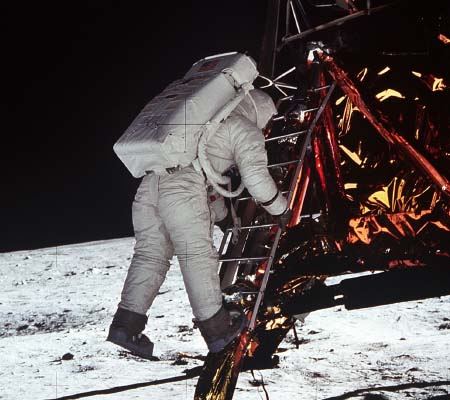
2019 is the 50 year anniversary of the moon landing
83. Leave nothing but footprints in Yellowstone
In a world first, eco-touring company Natural Habitat Adventures completed a zero-waste expedition with a small group of travellers in the world’s first ever national park: Yellowstone. It meant collecting all of the waste produced by the guests in a single small container. While on the walk the guests were asked to try and fit all of their individual waste into jam jars – a task that was seen as part of the challenge. Organised in conjunction with the World Wildlife Fund, the tour highlighted the growing problem of plastic waste in pristine environments like Yellowstone. The company prides itself on being a zero-carbon operation and is looking to build the lessons learned from the zero-waste expedition into its other products so you can be rest assured that you really are leaving nothing but footprints behind.
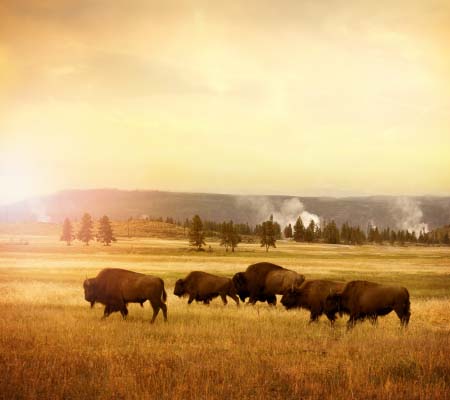
Leave nothing but footprints in Yellowstone
84. From little things big things grow
Not content with being a beloved drop in its native Australia, Little Creatures is now taking on the big guns in California’s craft beer capital of San Francisco.
The brand’s first international outpost is located on the waterfront at Mission Bay and boasts a microbrewery, full bar and a restaurant helmed by Executive Chef Ian De Leoz. Being within close proximity to the Giant’s home of Oracle Park and what will be the Golden State Warrior’s base at the Chase Centre, means that taking in a game followed by a beer or two is an easy option and makes it feel just that little bit more like being at home.
85. Is Santa Barbara the American Riviera?
With its laid-back, coastal vibes, sunny climate, Spanish-inspired architecture and palm-fringed beaches, Santa Barbara is a Californian enclave of cool. White-washed walls, muted tones and wicker furniture punctuated by (not literally) the odd cactus, bring a covetable barefoot luxe element to what has become a destination for design-hunters, surfers, and weekenders alike. Infinitely Instagrammable and just an hour-and-a-half’s drive from LA, this so-Cal city is an easy tack-on to a west coast road trip. Bed down in a 1920s bungalow at Belmond El Encanto, browse the minimalistic chic looks that seem to have inspired the style of our own Byron Bay at Jenni Kayne, and take care not to spill paella on your new white linen dress at chic Spanish eatery, Loquita.
86. A galaxy far, far away
On your round-the-world trip – take a detour off of this lump of rock altogether to a wild planet on the frontiers of known space in a galaxy far, far away. Disney is taking the concept of a theme park to the next level with the opening of Star Wars: Galaxy’s Edge. Set in a smugglers’ port on the planet of Batuu, the world is now officially part of Star Wars canon; you’ll bump into its characters while having a Jedi Mind Trick cocktail in the cantina (one of Star Wars’ infamous watering holes). Then there are attractions that let you take control of the Millennium Falcon and a soon to be unveiled rebel escape from the clutches of the Empire; you can even make your own lightsaber in a Jedi workshop.
87. Doing it LA style
Kelly Wearstler has been setting the benchmark in LA hotel style since she and her hotelier husband Brad Korzen opened the Viceroy in Santa Monica in the early noughties. Its impeccable design, recalling the glamorous golden years of Hollywood, put her on the map as a designer, and she has gone from strength to strength.
Now she (and Korzen) are back with a new venture, Proper Hotels. Having launched in San Francisco, the latest opening is Proper Hotel Santa Monica, featuring a riot of tones and textures. No detail is too small for Wearstler, with everything from the curvaceous settees to the blankets on the beds custom designed.

Check-in to Proper Hotel
88. Hawai‘i’s new wave (of street art)
Street art isn’t usually on the list of reasons to visit beloved Hawai‘i. But it stands to reason, that a place of such blue-sky, crystal-water beauty would inspire many a creative soul. One way to digest all this local artistic talent is to plan your vacay to coincide with the annual Pow! Wow! Street festival. Each February, the festival is concentrated around Honolulu’s Kaka‘ako neighbourhood and incorporates graffiti murals, block parties, artist talks, performances, and skate demonstrations.
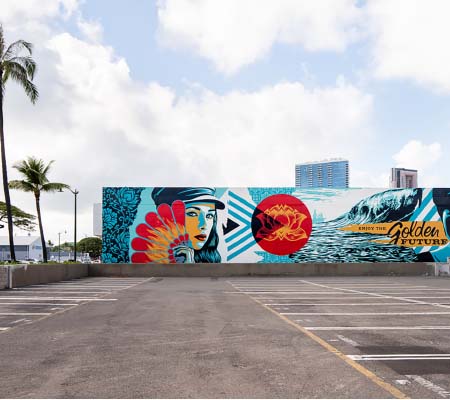
Hawai’i has a new wave of street art, and it’s pretty impressive
89. Cuba goes eco
While mention of Cuba typically places the hallowed streets of Havana in the mind’s eye, the countryside is now also emerging as a promising ecotourism destination. Its UNESCO-listed biosphere reserves, untouched tropical rainforests, mangrove forests and coral reefs have been somewhat protected by its lack of participation in capitalism over the second half of last century – leaving the country well primed to cater to the ever-increasing and crucial trend of sustainable travel. Cubans have been cottoning on: grooming their state parks for visitors, installing facilities and promoting trails you can book through Ecotur, among other operators.
90. Hot spot alert: panama
For a small country, Panama has a big story to tell – one that dates back some 10,000 years, spanning everything from ancient archaeological sites to cosmopolitan cities. While the extraordinary engineering feat that is the Panama Canal has put it on the map, there’s so much more to this small isthmus nation than the 77-kilometre-long channel that cuts through it.
Panama’s cultural fabric is a blend of mestizo heritage (a mix of European and Indigenous), African, Spanish, Chinese and Indian, bringing with it a unqiue fusion cuisine, diverse traditional arts, and music and dance styles that range from salsa to reggae. It’s also a hotbed of biodiversity with jaguars and pumas, sea turtles and reef sharks inhabiting rainforests and reefs across more than 1400 islands, making it a mecca for hiking, diving and snorkelling. And with a year-round summer climate, it’s always a good time to visit.
Deals
Tenth leg: Latin America to New Zealand
91. Fill up on award-winning Peruvian food
The World’s 50 Best Restaurants list is a pretty big deal; particularly so if you’re in it, and even more so if you’re in the top 10. This year, guess which cuisine didn’t make the top 10? That would be Italian. That’s right, there are no Italian restaurants in the crème de la crème of world restaurants. But guess which cuisine did appear in this exclusive club – twice? That would be Peruvian. So forget what you think you know about ceviche and roasted guinea pigs, because the food of Peru is not only bright and fresh, but entirely sophisticated. If you’re planning a trip to South America and like to dovetail your travels with good dining, put Lima’s two top-10 restaurants Central and Maido on your must-eat list. And if you’d like to explore the flavours before you head off, pay a visit to Melbourne’s Pastuso.
92. Join the jet-set
Things don’t get much more jaw dropping that travelling by private jet, and the good news is you don’t have to be a Kardashian to partake. Captain’s Choice, purveyors of awe-inspiring itineraries, have put together the ultimate South American journey, departing Sydney by private jet and being ferried from one country to another to attend polo matches in Argentina, lunch at the Iguassu Falls, soak up the sun in Rio de Janeiro, be humbled by Machu Picchu and commune with the mysterious mo‘ai on Easter Island (among other things, including four nights cruising the Galápagos Islands by privately chartered ship).
93. Sleep on Bolivia’s giant salt lake
Located at 3600 metres above sea level, the otherworldly Kachi Lodge is the only accommodation within Sala de Uyuni, the largest salt flat in the world. Guests sleep in space-like geodesic domes that were designed for unobstructed stargazing, and which also have surreal views of the vast salt flats that stretch out before them. Each of the simple but beautifully furnished domes has a private bathroom and heating, while the onsite restaurant Gustu is an off-shoot of the awarded La Paz restaurant of the same name and serves authentic and inventive Bolivian cuisine.
94. Five star at the bottom of the world
Picture this: a huge wall of glass at one end of a plush two-storey suite, framing the deep blue of the Southern Ocean peppered with colossal icebergs, the craggy black and white landscape of Antarctica beyond. It’s the incredible proposition being offered by the likes of expedition cruise specialists Seabourn and Ponant, who are bringing a new level of luxury to the waters of the world’s last great wilderness: Antarctica. The aforementioned luxury two-floor apartment-style cabin will be available on the Seabourn Venture, replete with its own submarine that can descend 300 metres to explore wrecks and reefs. It’s due to set sail in 2021 – plenty of time for you to start saving then.
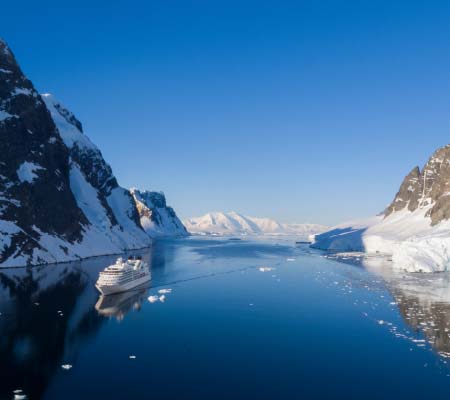
Five star luxury in Antarctica
95. Meet the locals
Antarctica’s Emperor penguins are a curious bunch. The first explorers to the frozen wilderness described strange-looking creatures that stood up to 70 centimetres in height, huddling together against raging blizzards in the most inhospitable place on Earth. But the Emperors remain an oddly beautiful sight for intrepid contemporary explorers, too.
These birds are one of the more difficult wildlife experiences to tick off (infuriatingly so if you’re a twitcher), owing to the extreme location, but that shouldn’t stop you. Take a Penguin Safari with Polar Cruises, whereby you’ll fly to Union Glacier Camp from Punta Arenas, Chile, touching down on the ice cap near a rookery consisting of thousands of the birds, to get a perfect shot of these iconic animals plodding (and belly-sliding) through a vast white desert.
96. Tahiti cranks the luxury up to eleven
Close your eyes and visualise your ultimate island paradise. Is it caressed by calm waters that glint like a perfectly cut diamond? Are the sands softer than 1000-thread-count sheets? Are you serenely napping in your tropical-luxe villa? You must be in Tahiti. And if you’re in Tahiti, you must be at the new five-star Nukutepipi resort. With everything softly bleached under the Tahitian sun, your days might take you from lagoon to spa to cocktail bar and back again. As far as private island escapes go, Nukutepipi may not break the mould, but nor does it need to in order to register a spike in our luxe lust.
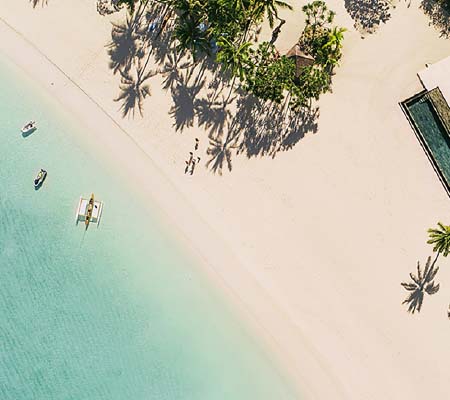
Find your ultimate paradise in Tahiti
97. Island life
Of Fiji’s 333 blissful islands, Kokomo Private Island is one of the most coveted. It is a place where out-of-this-world meets down-to-earth, and that’s the kind of luxury we crave these days. While butler-style service and world-class cuisine are part of its fabric, so too are sandy toes and salty hair. Refreshingly, kids are properly catered for too, with a playground, kids’ club, and nanny services on hand. Accessed only by seaplane or helicopter from Nadi, the dreamy resort is set on a 57-hectare lush green island encircled by sugar-white beaches and iridescent water. It’s also a nirvana for aquatic enthusiasts – just a short boat ride will take you to more than 40 dive sites, including renowned Great Astrolabe Reef, as well as some of Fiji’s most exceptional surf breaks.
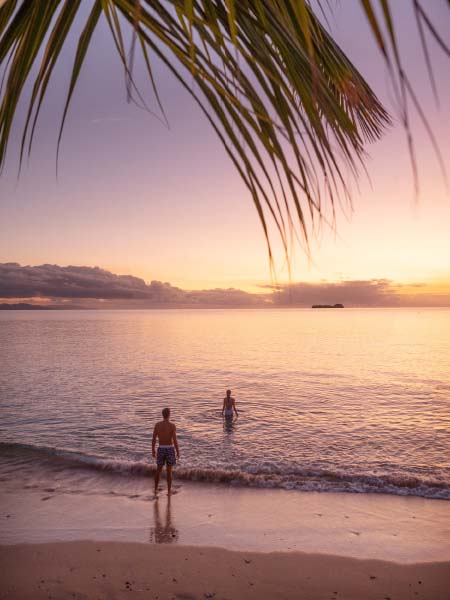
Private island paradise
98. Land of the iguana
There are many good reasons to make your way to the small Fijian island of Malolo: there’s the pristine lagoon and coral reefs, ripe for snorkelling; white-sand beaches and fabulous resorts to base yourself at. But you should also come to walk through its rare tracts of tropical dry forest that Likuliku Lagoon Resort Fiji by Ahura Resorts is now helping to restore following the rediscovery of the brilliant green Malololo Island crested iguana in 2010, once thought to have become extinct; the resort suddenly found itself in a position of great responsibility to ensure the protection of this beautiful, rare species and its similarly rare habitat. Make sure you tear yourself away from the beach to take a tour of the Iguana Sanctuary and dry forest habitat with Likuliku Lagoon Resort Fiji’s very own environment manager.
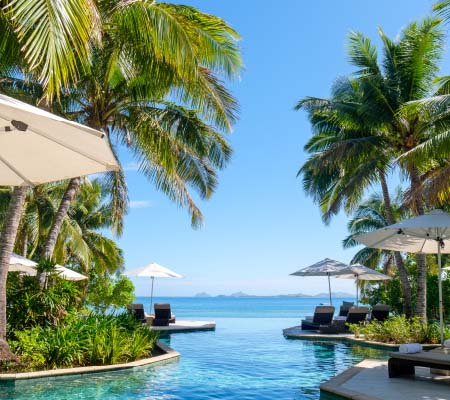
There are many good reasons to make your way to the small Fijian island of Malolo
99. Camp comfort
Above and beyond the stunning South Island vistas of jutting mountains and glassy, still lakes and the old-school style of its cosy cabin accommodations, the feel good factor of staying at Camp Glenorchy comes from knowing that you have stepped lightly on this awe-inspiring landscape. Aiming to provide a holiday option that is in harmony with nature, Camp Glenorchy utilises a raft of sustainable initiatives to achieve its earnest goal, from using non-toxic construction materials to creating over 100 per cent of the energy it uses, to stringently managing its waste and water, including using composting toilets. A sense of satisfaction is the ultimate souvenir after a holiday here.
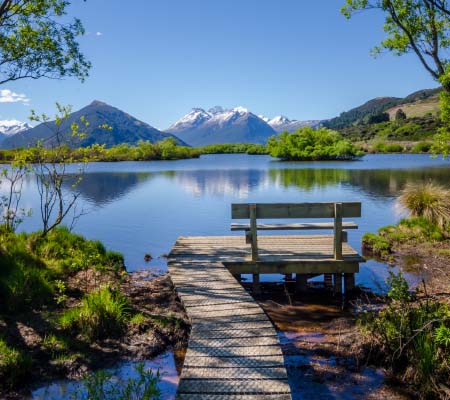
South Island vistas of jutting mountains and glassy, still lakes
100. Walk the Paparoa Track
If you need another excuse to head across the ditch, this is it. The 55-kilometre Paparoa Track on the South Island’s west coast is the country’s first new Great Walk in 25 years. Catering to both intrepid hikers and bikers alike, it crosses the Paparoa Range, leads through alpine landscapes and lush rainforests, and boasts views of the Tasman Sea and Southern Alps. It will also connect with the Pike29 Memorial Track, which will lead to the site of the former Pike River Mine and is dedicated to the memory of the 29 men who lost their lives here in 2010. Set to open in December, the Paparoa Track will take approximately three days to traverse by foot and two days by mountain bike, with three accommodation huts available to pre-book.
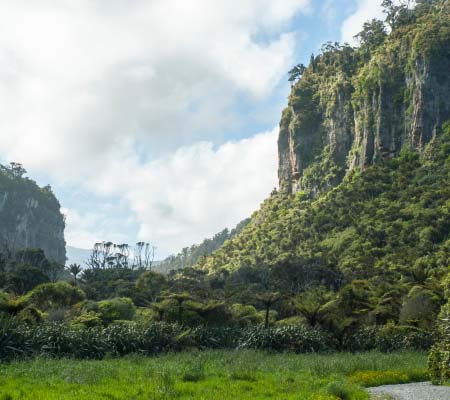
The Paparoa Track is New Zealand at its best
